Ray-Finned
Fish
This
page was born 12/02/2009. Rickubis designed it.
(such as it
is.) Last update: 04/15/2022
Images
and contents on this page copyright ©2002-2022 Richard M. Dashnau
Go
back to my home page, Welcome
to rickubis.com
Go
back to the RICKUBISCAM
page.
Fish
are also part of nature, but most of the time we don't interact with
them. Sometimes, I've been surprised by very interesting fish
doing very interesting things, and I'm
gathering them on this page.
Sharks are fish, of course, but they are in a different group. Fish on
these pages are defined by having a skeleton composed of rigid
bone.
Sharks and their relatives
have skeletons made of cartilage. I've put them on a different page.
06/05/2021 (posted
6/13/21) I
visit Fiorenza Park frequently . It's pretty close to home, it covers
362 acres, it has about 6 miles of trails and a wonderful collection of
wildlife.
The
weather was nice, and the high water was apparently enough to induce
some Gar to spawn. I could see one group of gar moving along
the
surface, and I tried to capture some video
or photos of them when
they gulped air, or came up to the surface. The water was
murky
as usual, so I couldn't see much below the surface. But, I watched them
swim over submerged
portions of sidewalk, and over the low
footbridge. I didn't get good photos, and even the frames from the
video didn't work well...but some of the video clips came out
ok.
I came to realize
that there were more than two fish involved--in
fact there might have been 3 or 4 fish following the leader. I got only
a few quick looks at them from the top--but when I did I saw a really
broad
snout. I'm pretty sure that I was watching Alligator Gar (Atractosteus
spatula)! Examine the video clip (mp4) to see them in
action. It's possible that these are Shortnose Gar (Lepisosteus
platostomus), but
that broad head makes me think otherwise. When water
temperature
and depth is right, gar swim over flooded areas and deposit stick eggs
on vegetation. The males
which are swimming behind, fertilize the eggs. That's what
these gar seemed to be doing.
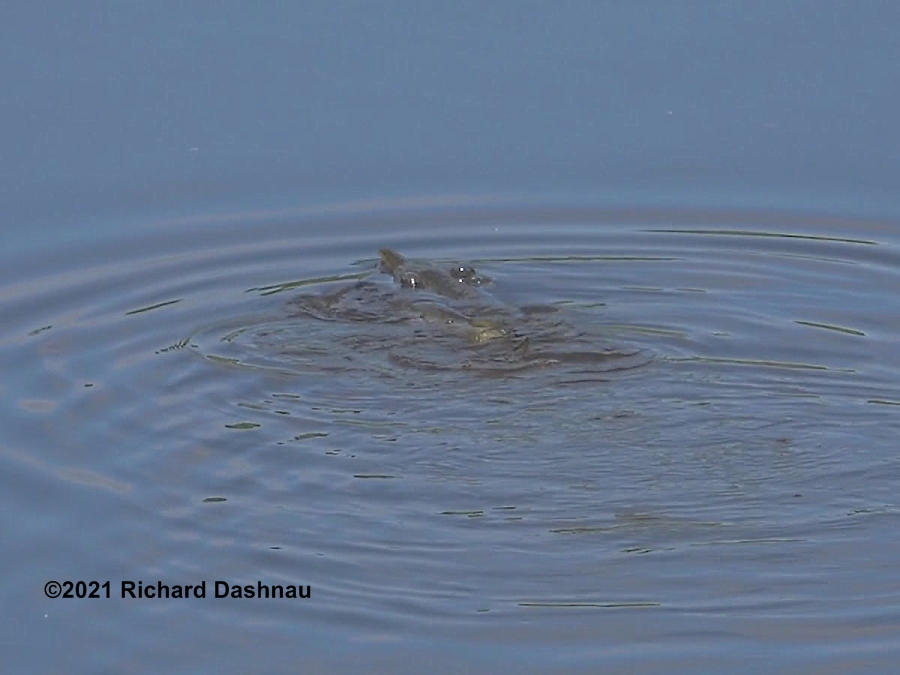
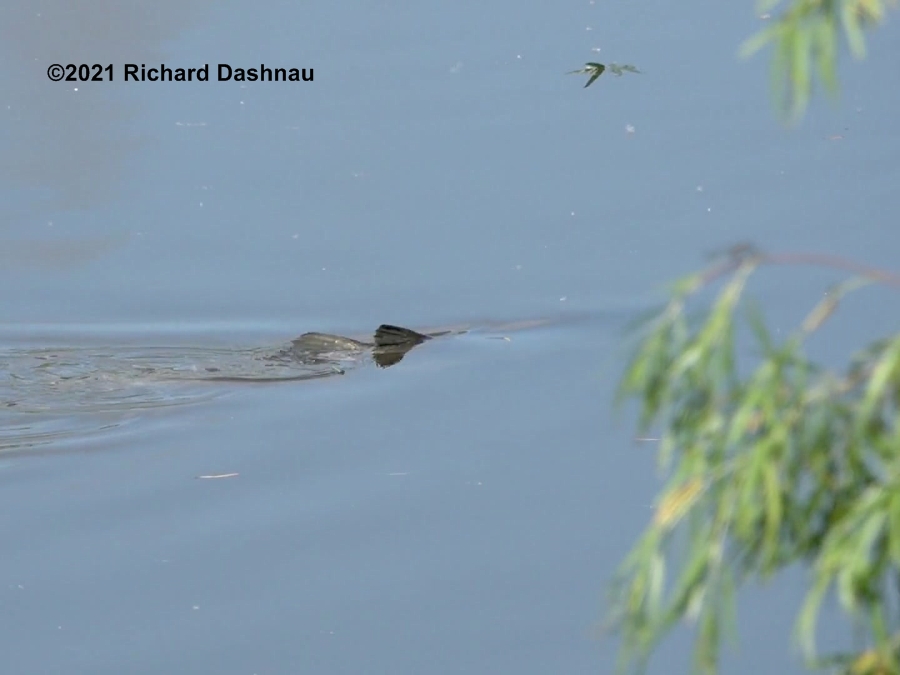
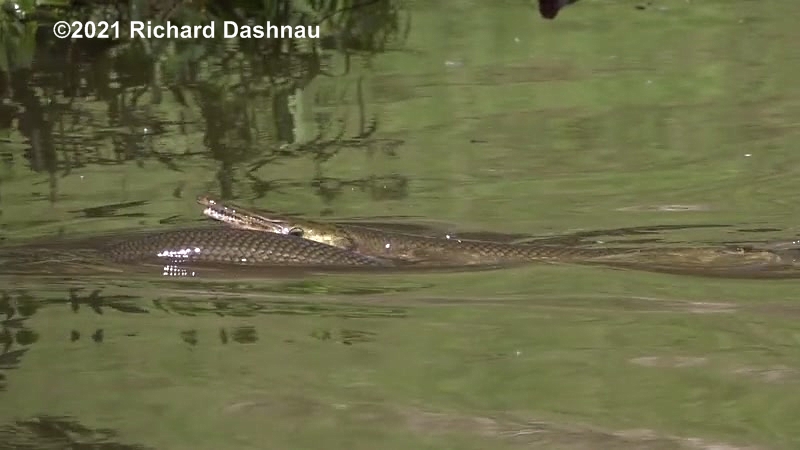
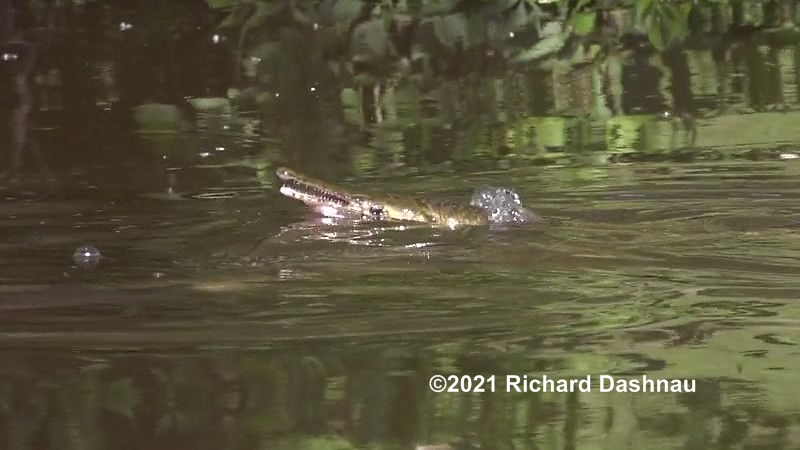
FIRST VIEW, SWIMMING
TAIL FINS SHOWING
GETING
AIR--LOOK AT THE TEETH!
MORE
TEETH
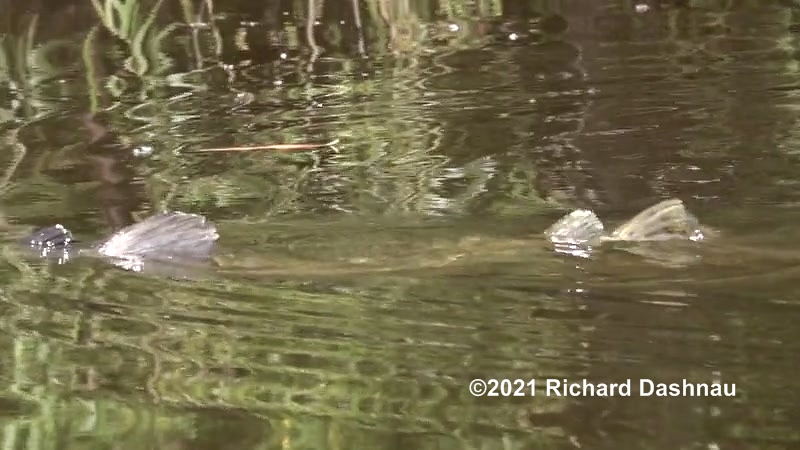
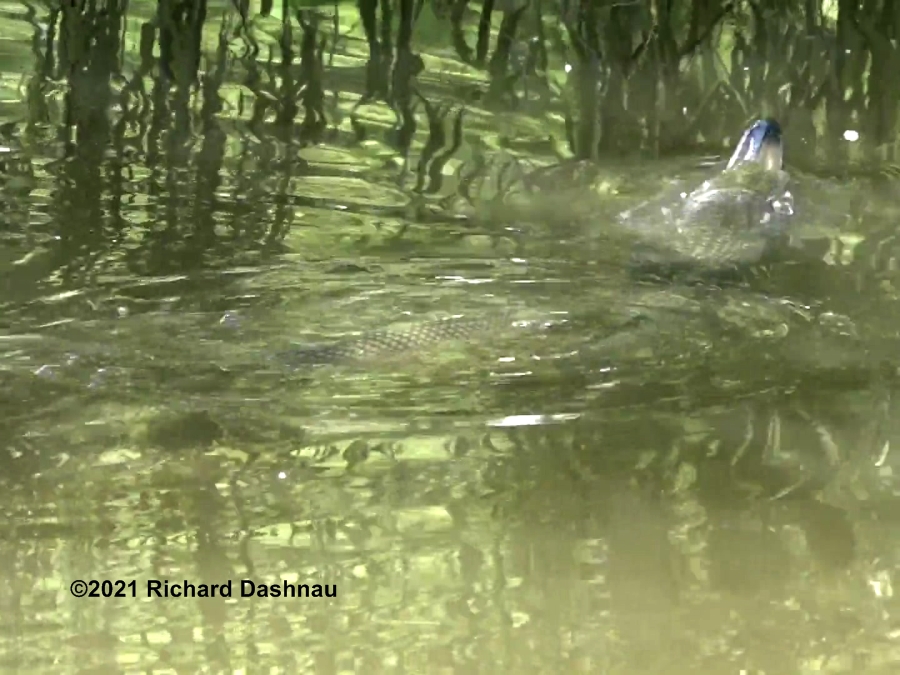
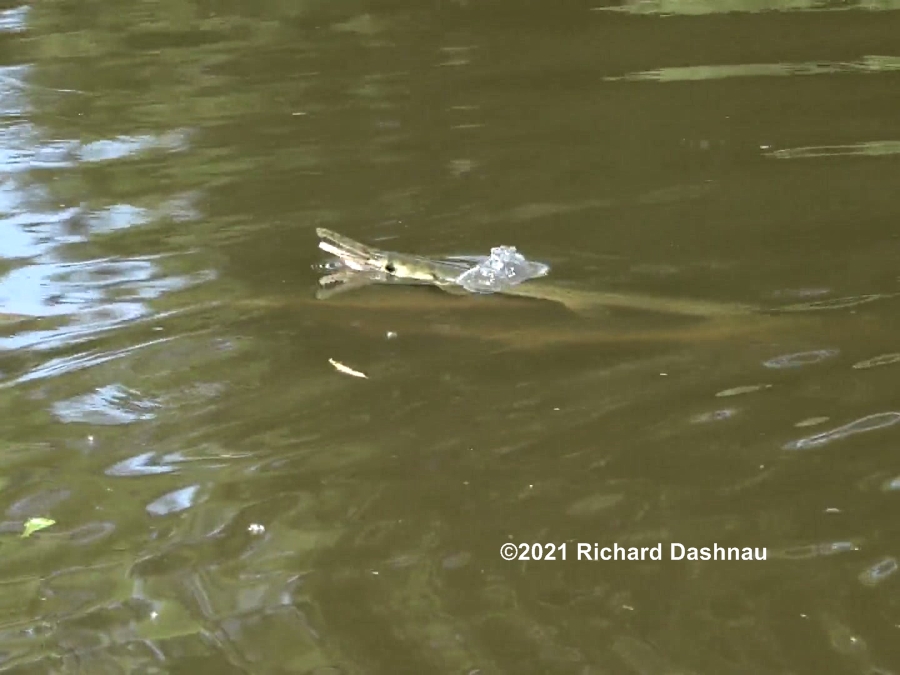
BIG TAIL ON THE LEFT, FOLLOWED BY
SMALLER
BROAD SNOUT VISIBLE
ONE
MORE BREAKING SURFACE
03/06/2021 I
visited Fiorenza Park North to get more images to document the "fish
kill" from the Big Freeze of Feb.14-20, 2021. I was
also
hoping to find the "eel" carcass
I
mentioned in a previous post but it was gone. The images
below
were taken along a 200-foot(approximately) long stretch of shorline on
the North edge of the South lake
at the park. Try this link and it should show a Google map view of the
area. Google
Map Link. Most (if not all)
of the carcasses seem to be of armored catfish (Loricariids) of various
sizes.
Since
they are of various sizes, I believe that this show that mostly these
species were affected, and that this isn't some kind of arrangement
caused by size. On the other hand,
other carcasses might have been
easier to consume than these armored ones, so might have been carried
off. I believe I've seen live examples of Hypostomus plecostomus and
Pterygoplichthys anisitsi at this park, so the carcasses could be at
least one of those. Clicking on an image
will open it larger in a new window.
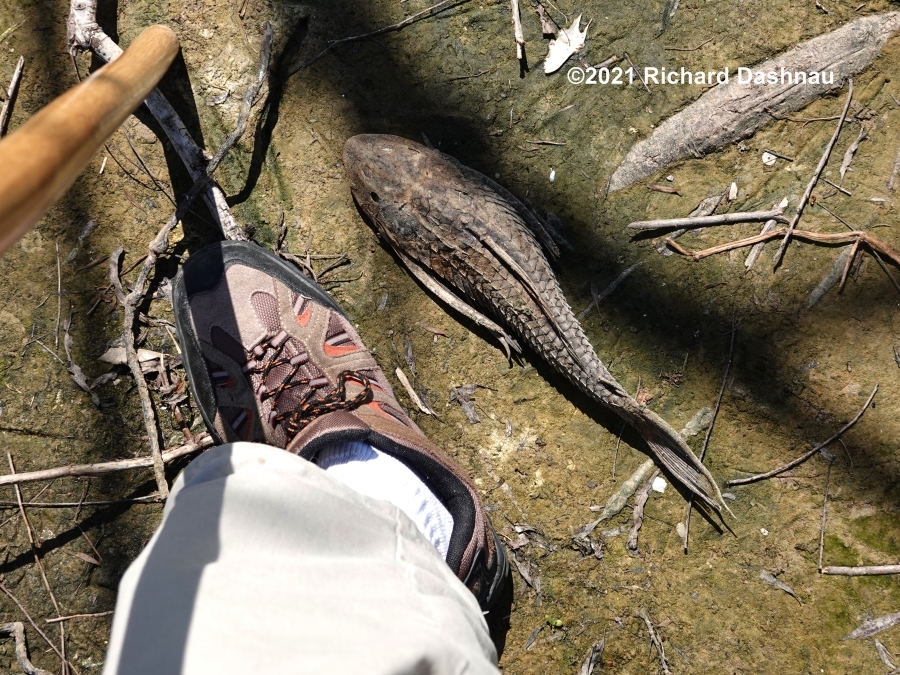
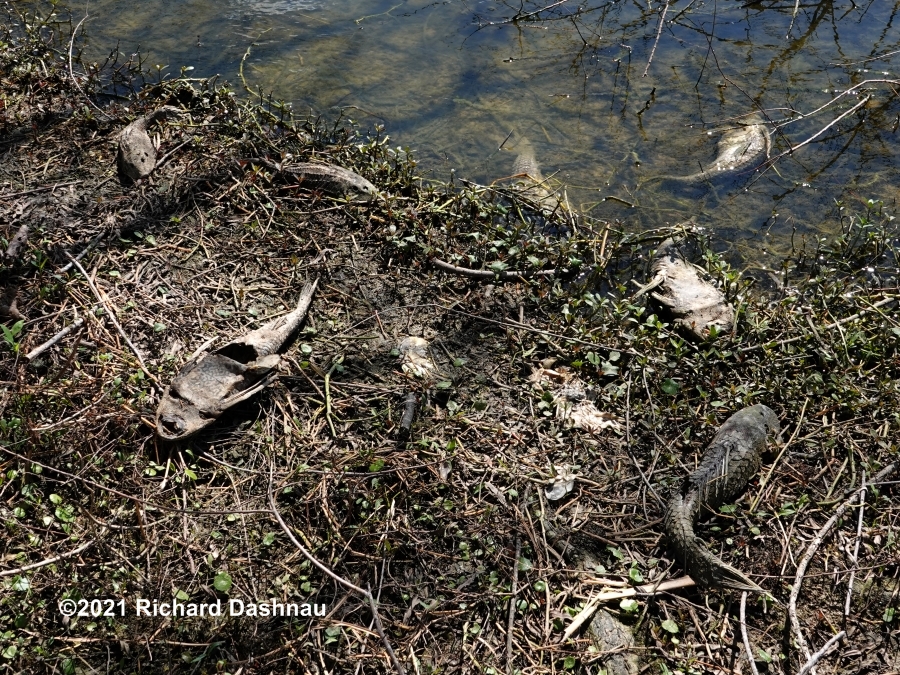
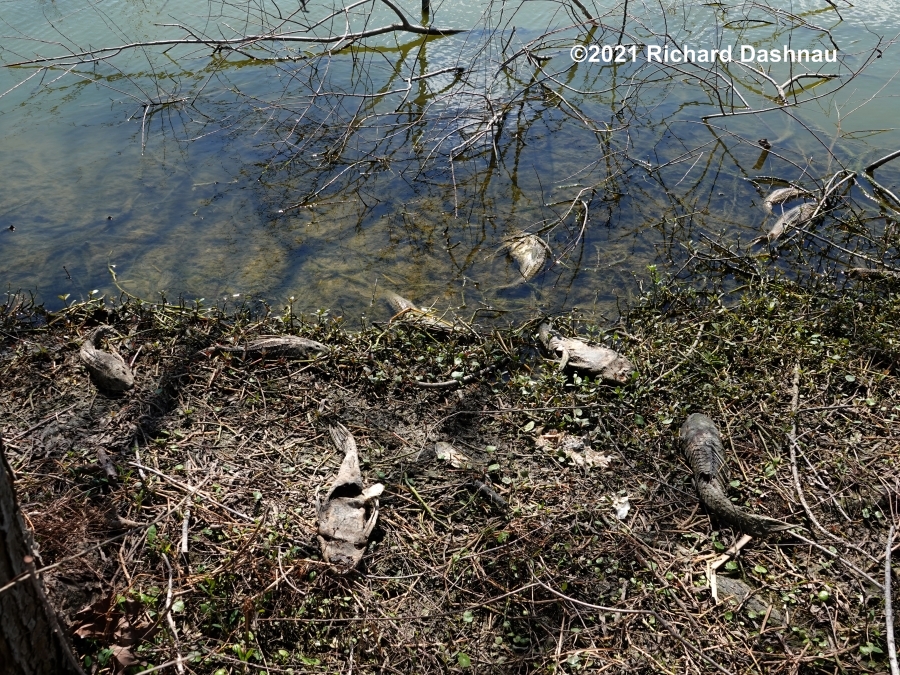
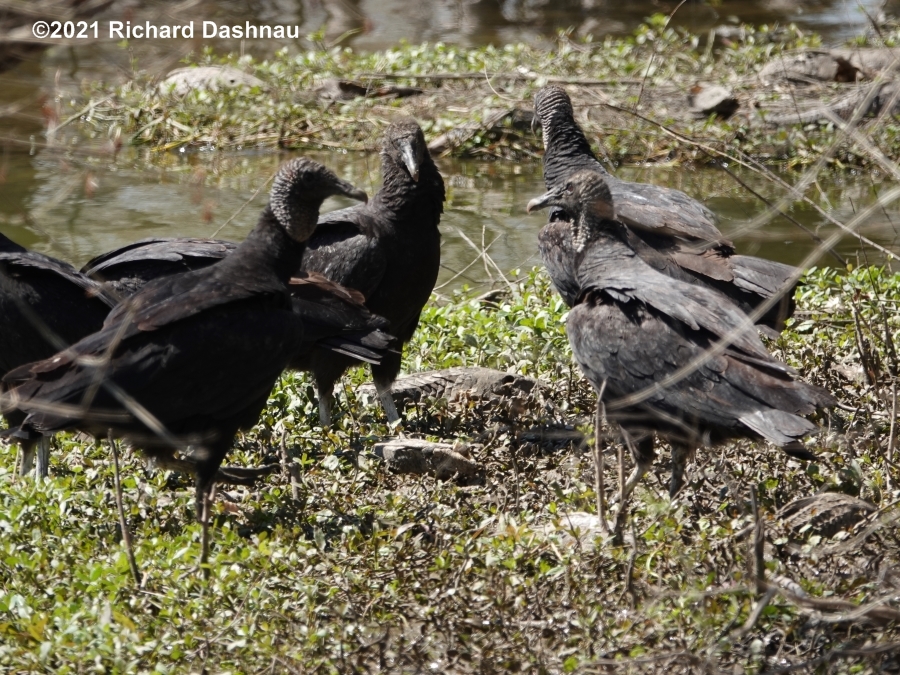
Carcass by my size-11 foot
Black Vultures
still picked at the
carcasses.
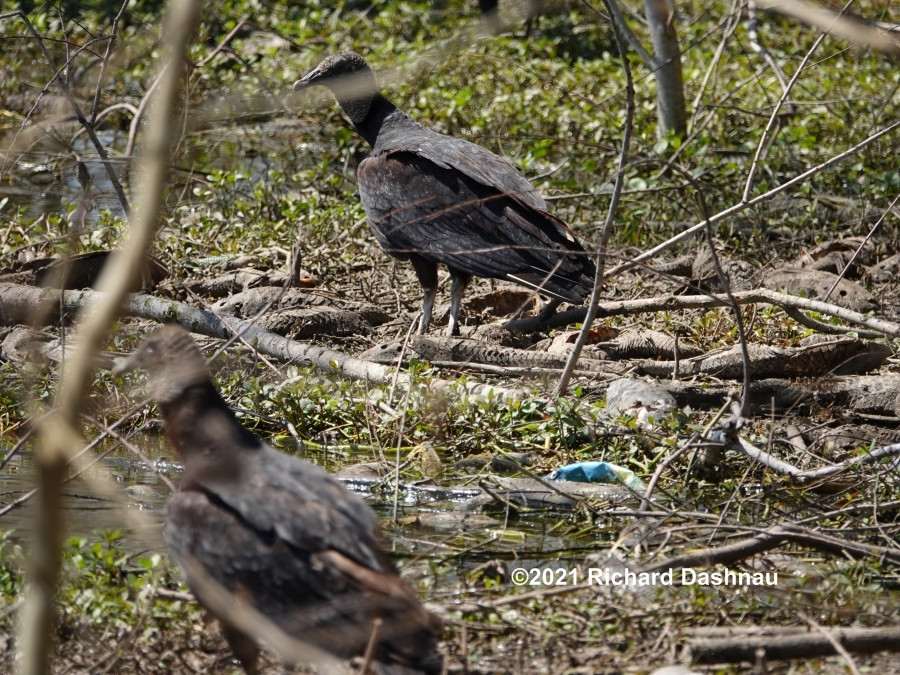
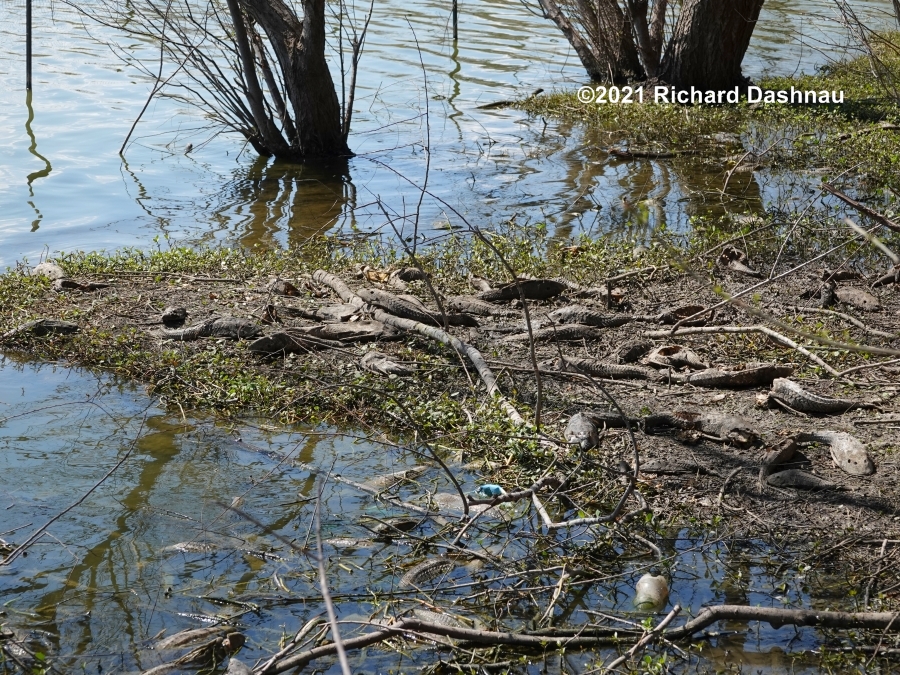
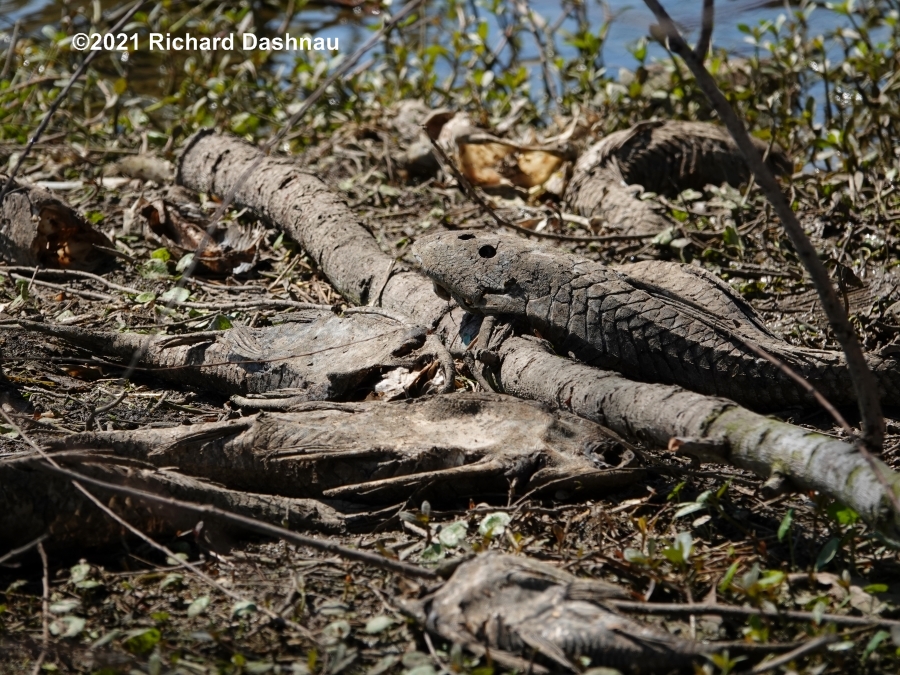
B.Vulture (Coragyps atratus) in a pile.
Closer view of one pile.

Stitched panorama of close view of one pile.
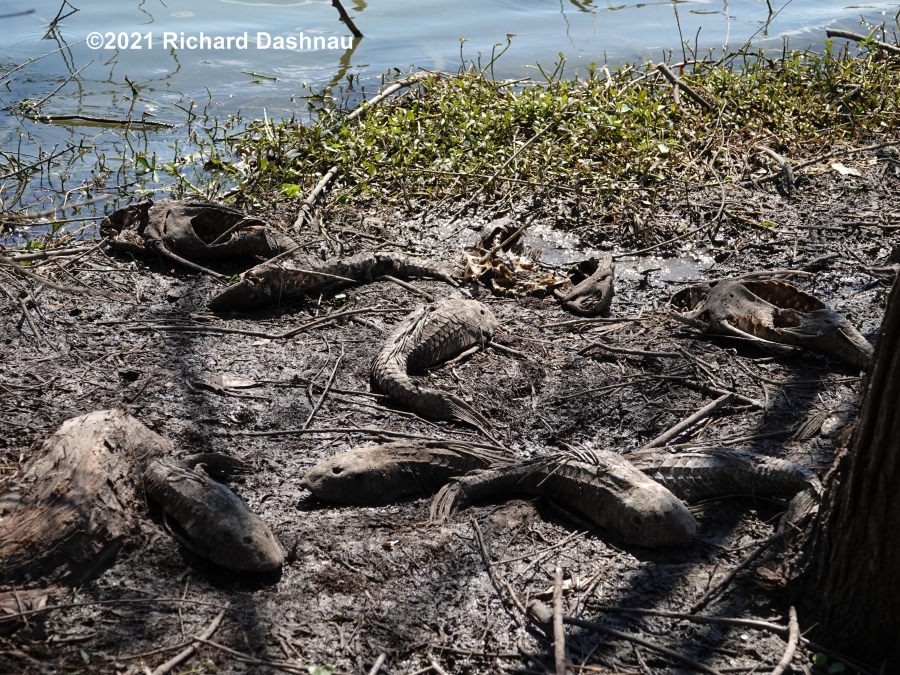
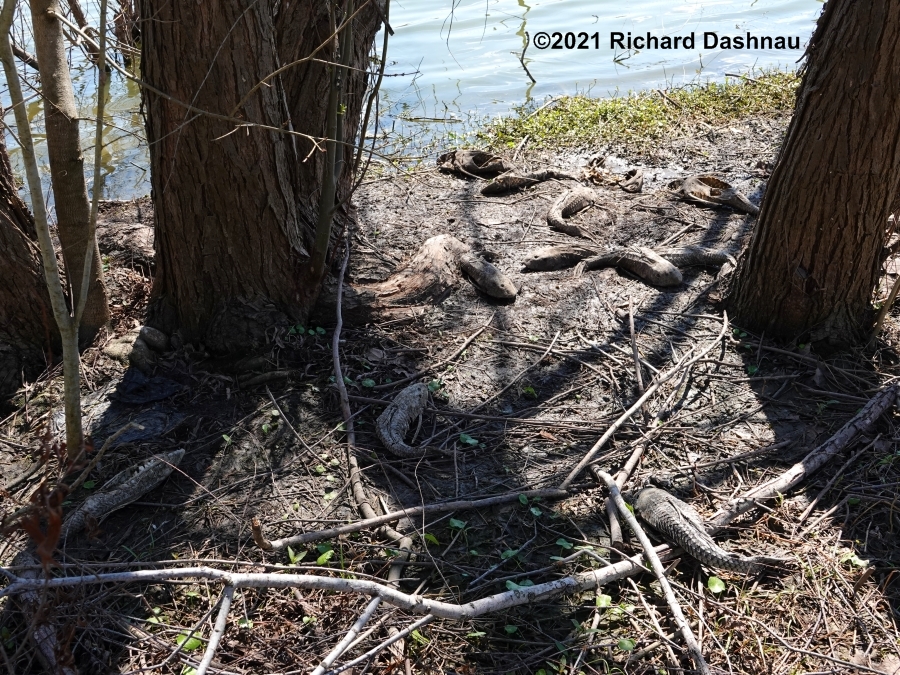
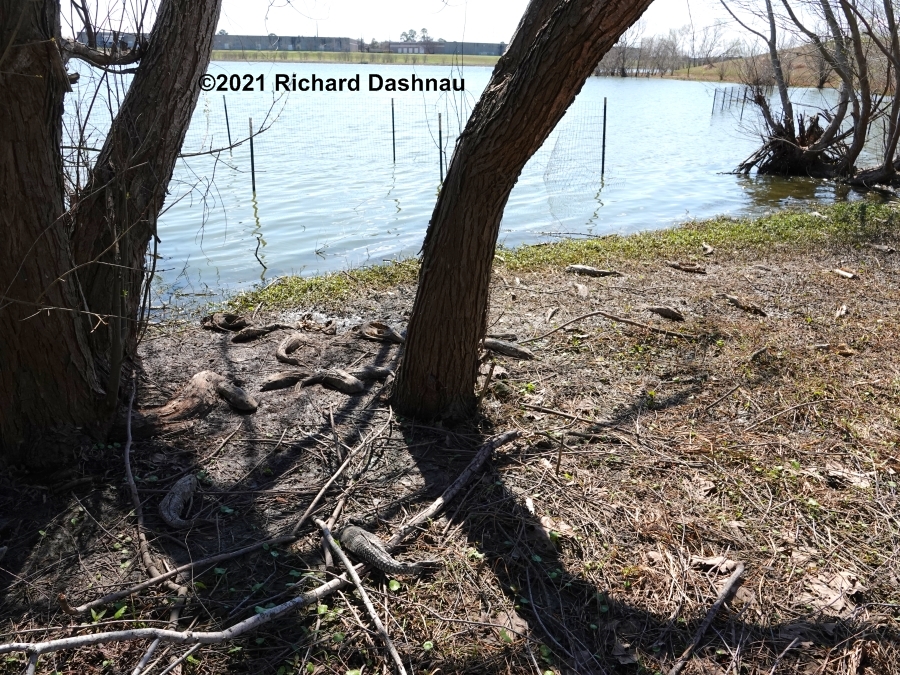
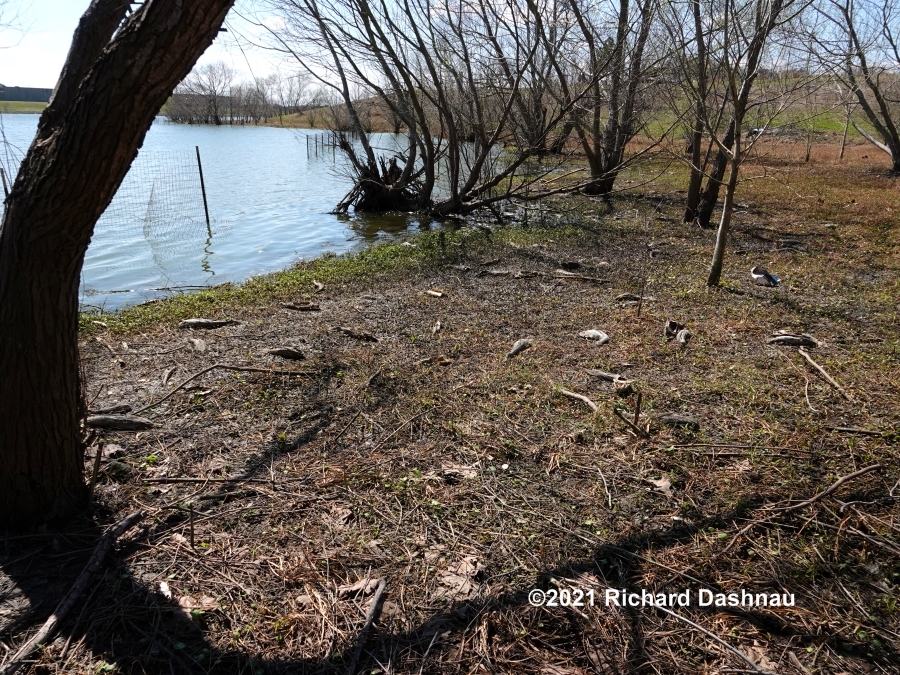
I shot these four progressive views to capture the extend of the
carcass field--and this was just one part of the coverage.
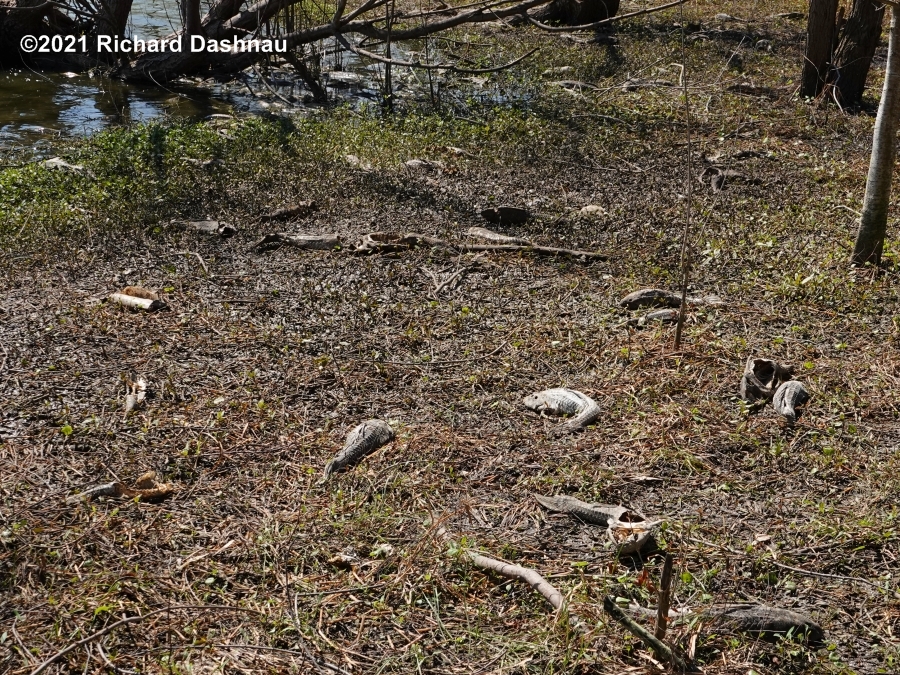

This is a camera-built
panorama just a bit
further West. Fish carcasses were scattered everywhere.
03/04/2021 I
visited Fiorenza Park North again, It's not too far from home.
I'm not sure, but I think the water level has dropped since
my
last visit.
Today, I discovered that the armored catfish (various
species?) apparently did not come through the freeze even unscathed.
There were many dead ones
scattered around the shoreline.
There were many different sizes. Maybe they had
died during
the freeze but their carcasses had been hidden by deeper water.
They were
certainly visible today!
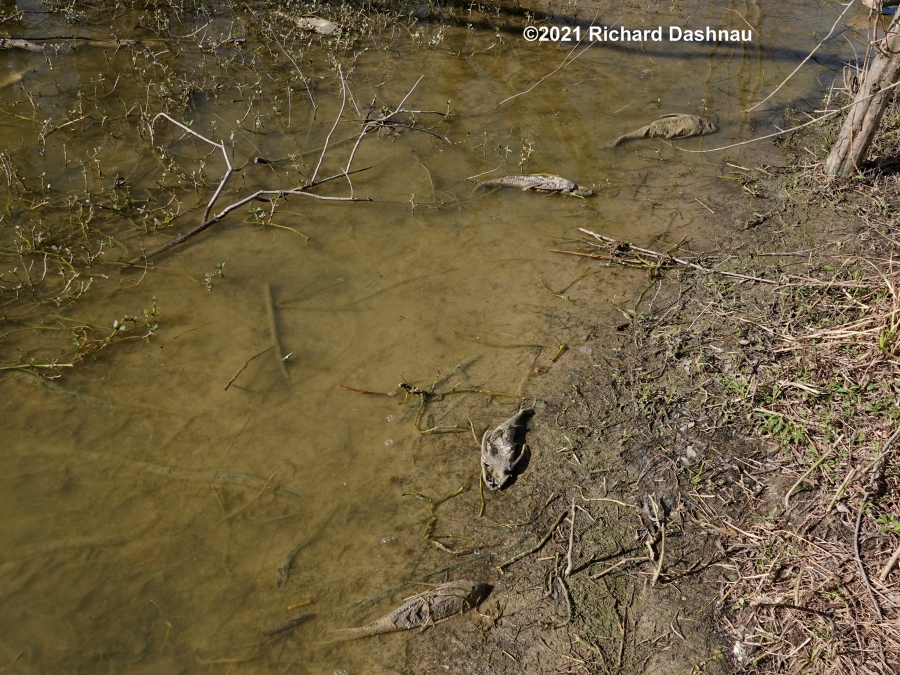
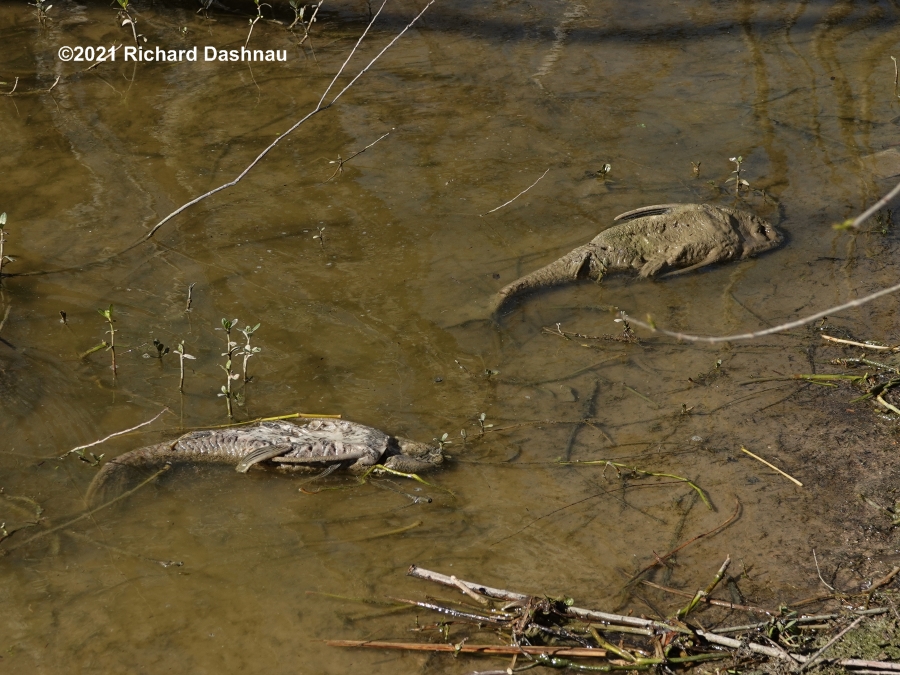
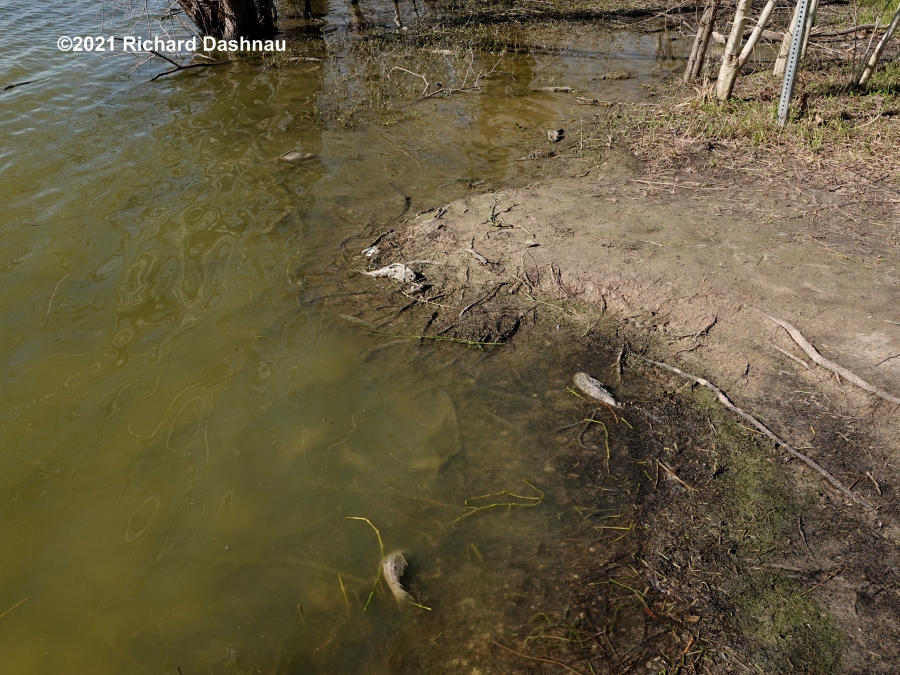
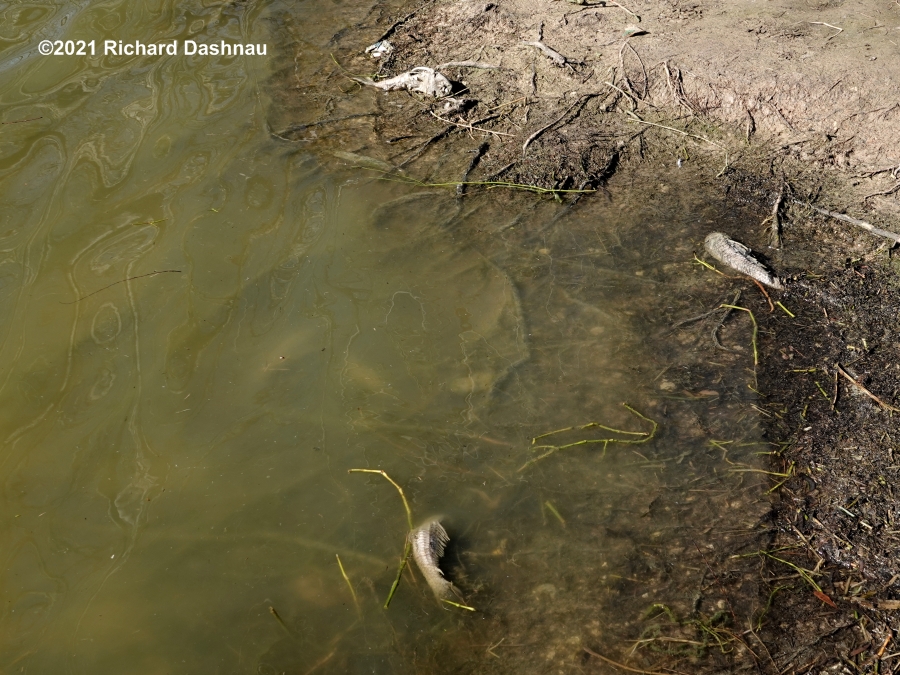
5 in
this picture.
Two
of those 5, closer.
At least 10 in this
picture.
A closer view, some are submerged.
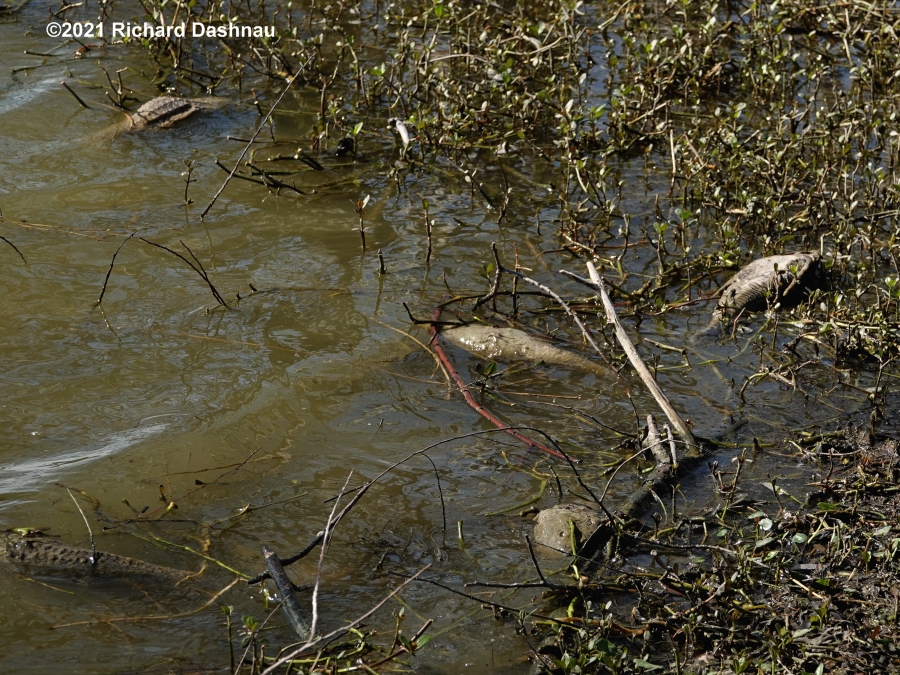
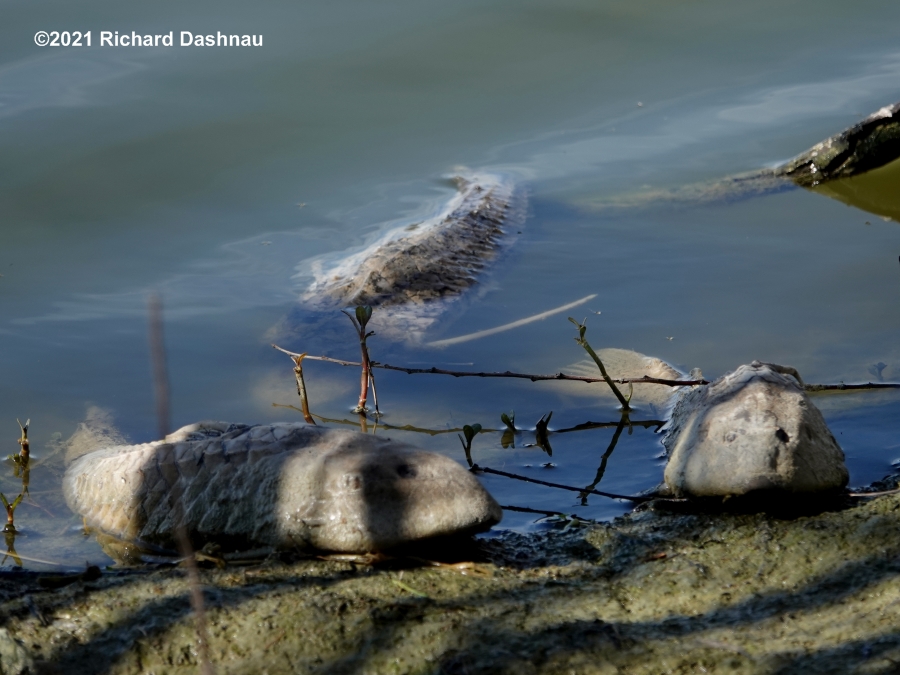
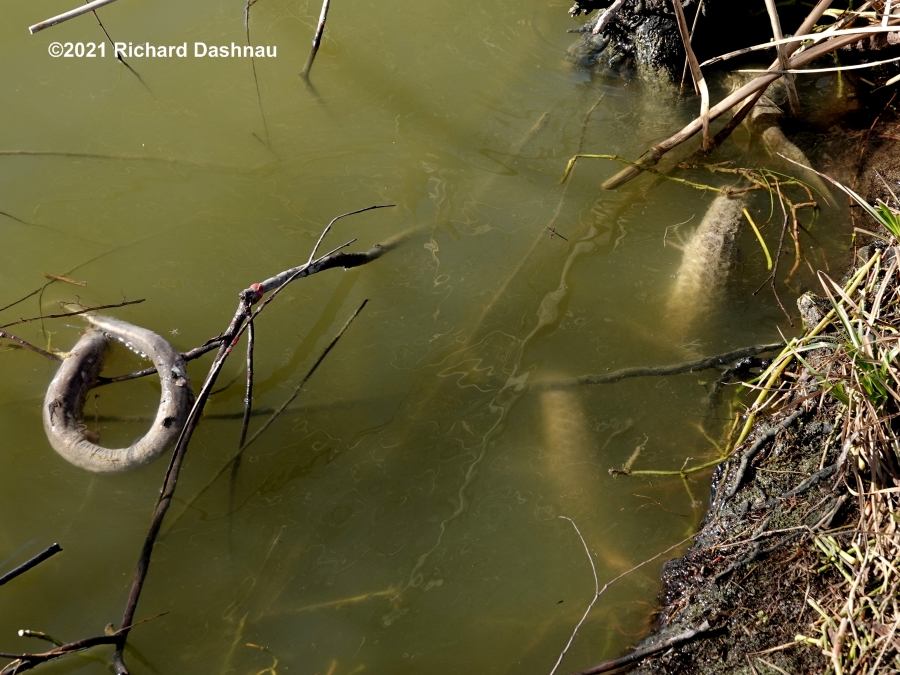
And there are more.
I couldn't get closer to these big ones.
Two
more, and something very interesting!
I
noticed the uncommon carcass floating near the bank. I was able to get
it on land, and I took photos of it. I could think of two
"tube-shaped" animals
that it might have been. One is an
amphibian, and one is a reptile. I took my pictures of details that I
thought would help me identify the animal. As the
pictures
below will show, the carcass had been partially-eaten, and was also
decomposing. So, what could it be?
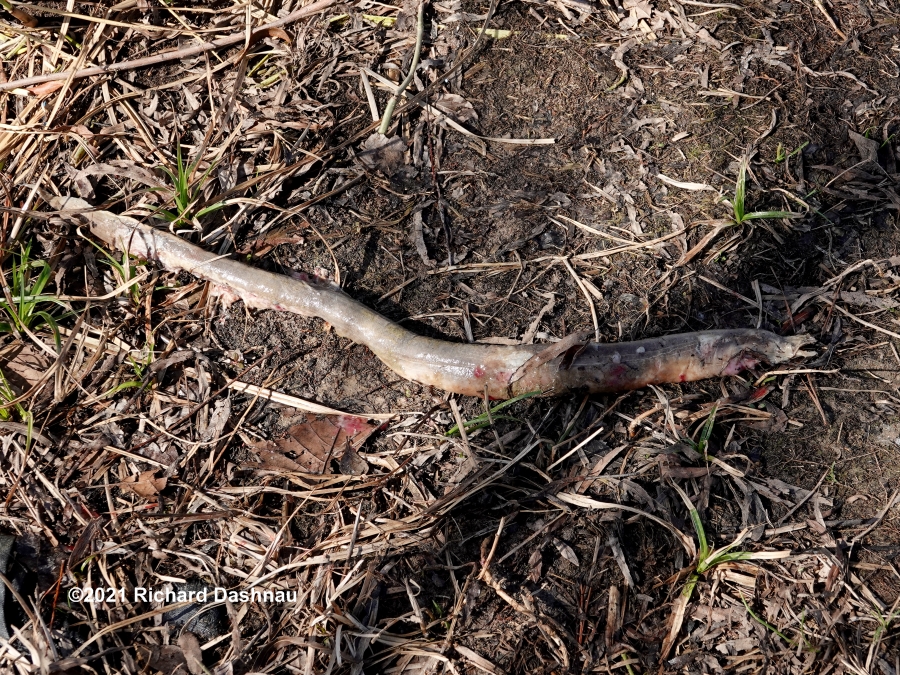
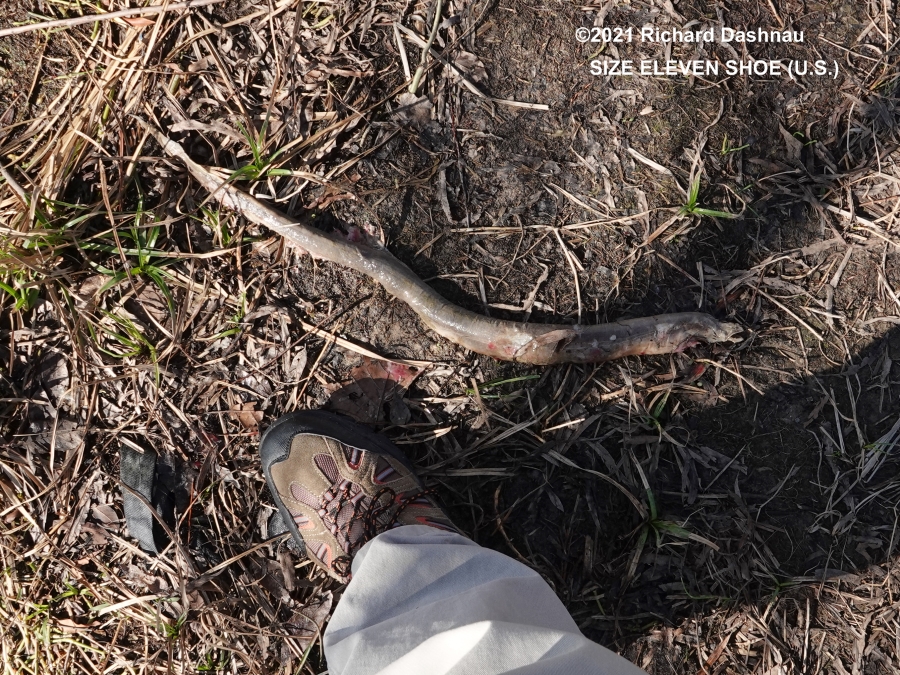
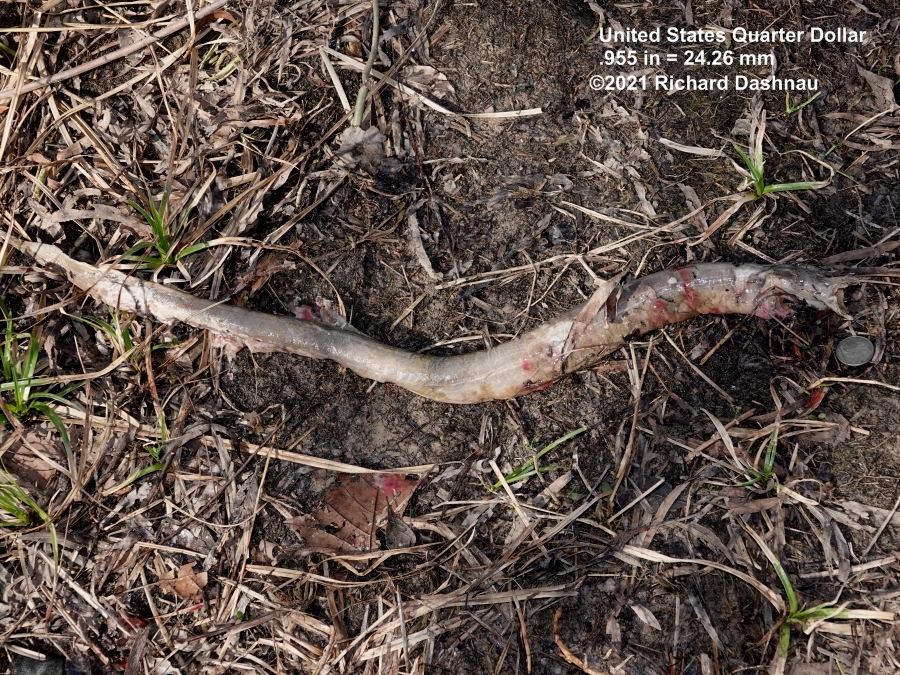
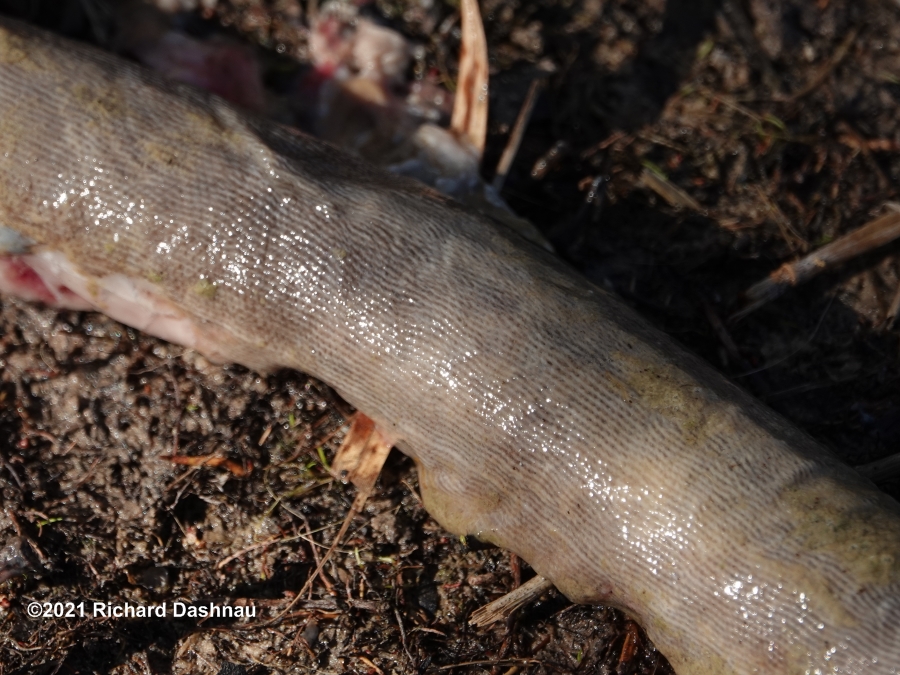
Carcass is in pretty bad shape.
My
foot next to the carcass for scale.
There's a quarter near the head
Here's a look at
the skin. It isn't smoooth.
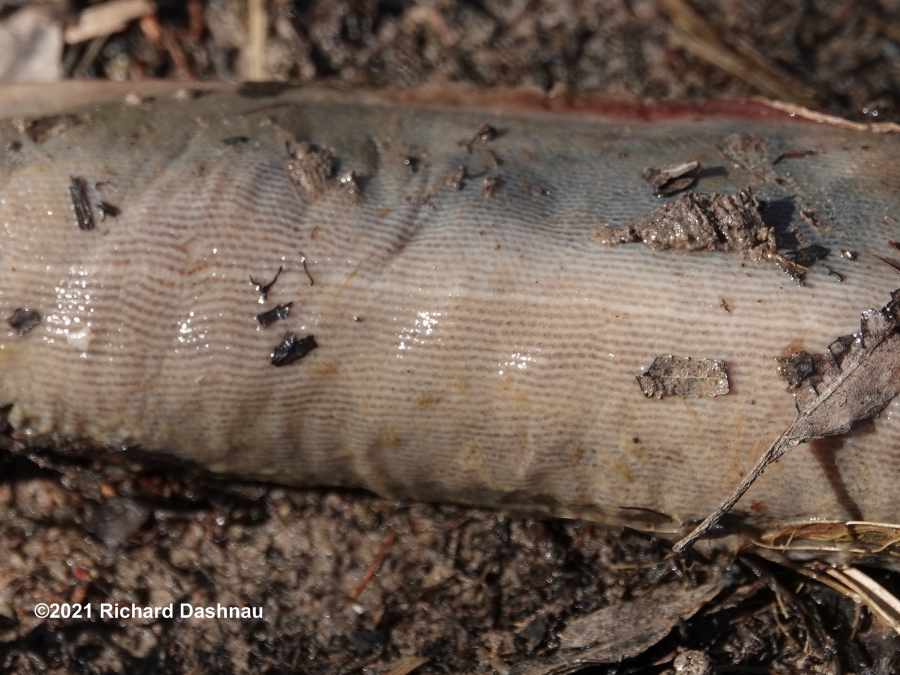
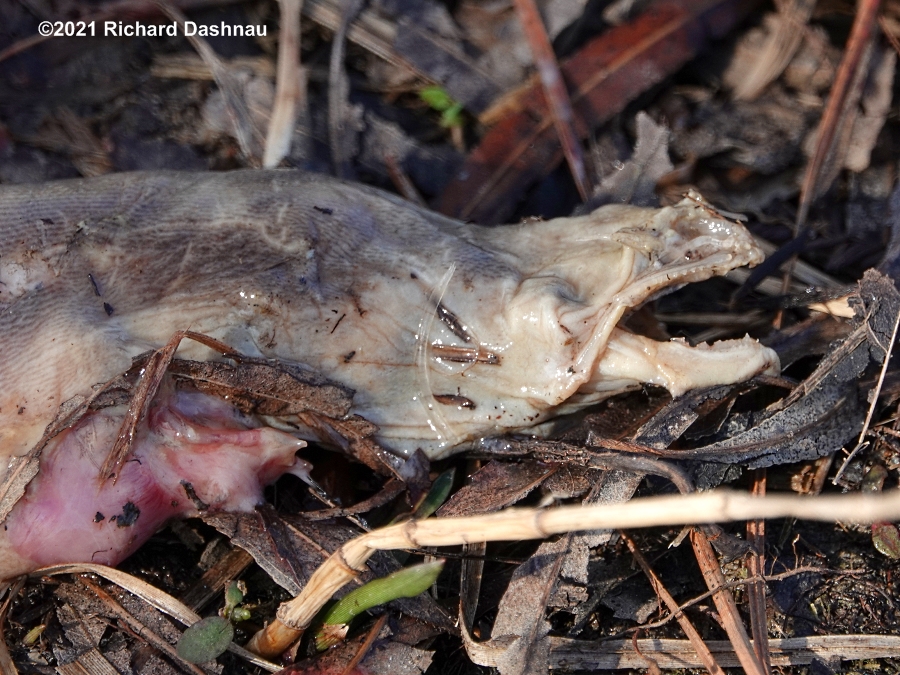
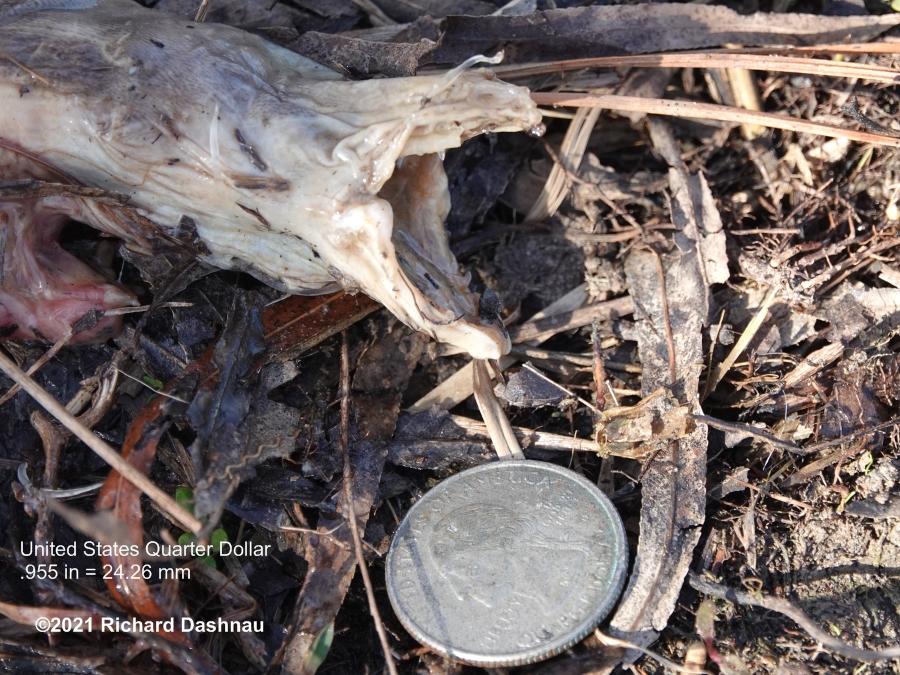
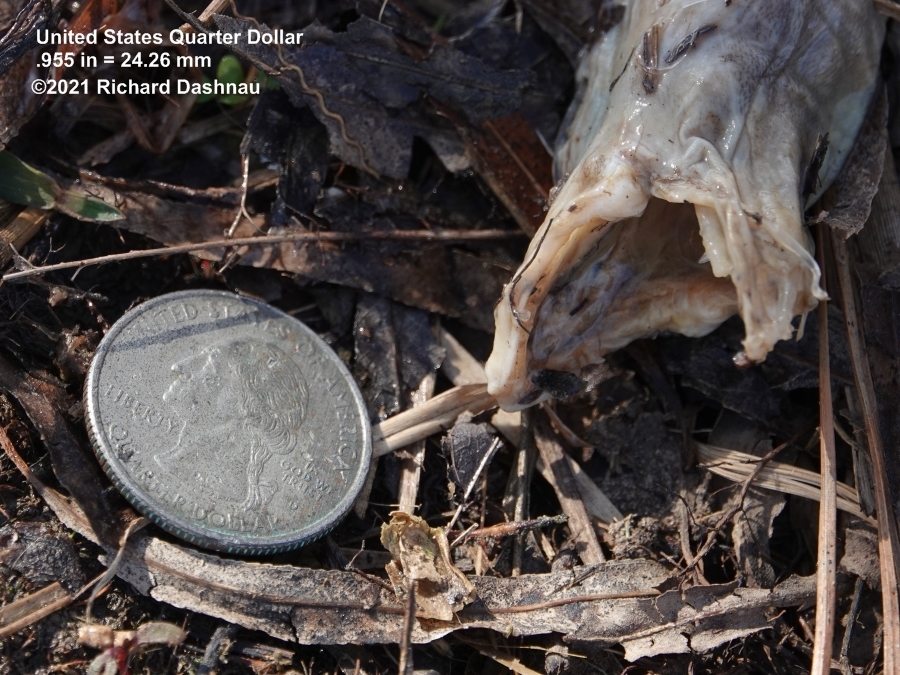
A look a bit closer. Are those scales?
Pectoral area
behind the head is chewed off
The
head, no external gills.
Some small teeth
show, not hooked.
One of the animals that have
a similar shape is a snake. Let's compare with some pictures
of Diamondback
Watersnakes (Nerodia rhombifer) that I've taken in the past within a
few yards
of
where I found this carcass. The carcass has no color
pattern--even if it doesn't match this snake, it doesn't match any
others, either. The scales on the carcass are the wrong size
and
shape-
for this snake, and just about any other local snake. Can't
see on the two snake pictures, but the carcass has NO large belly
scales. The few teeth visible in the skull are wrong for a snake, too.
a
snakes teeth are thin, sharp like needles, and the tips curve
backwards.
I couldn't see any eyes on the carcass, so can't really
compare
those. The pictures don't show it well, but the tail
of
the carcass was flattened vertically. No local species of snake have a
tail that's flattened so that it pushes well--like an alligator's tail,
or a tadpole.... And that brings up the second animal
that I thought it could possibly be.
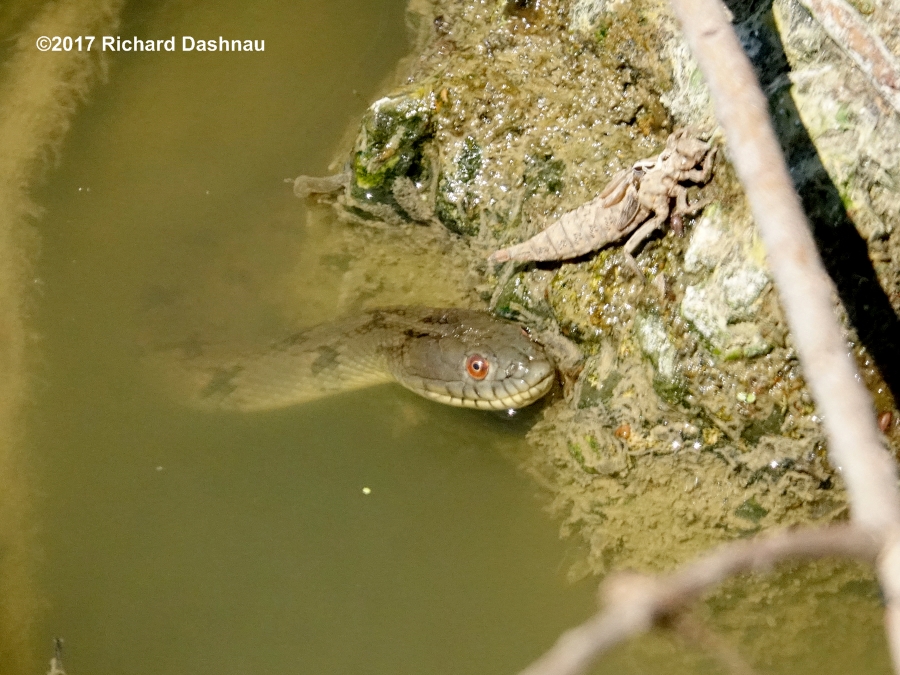
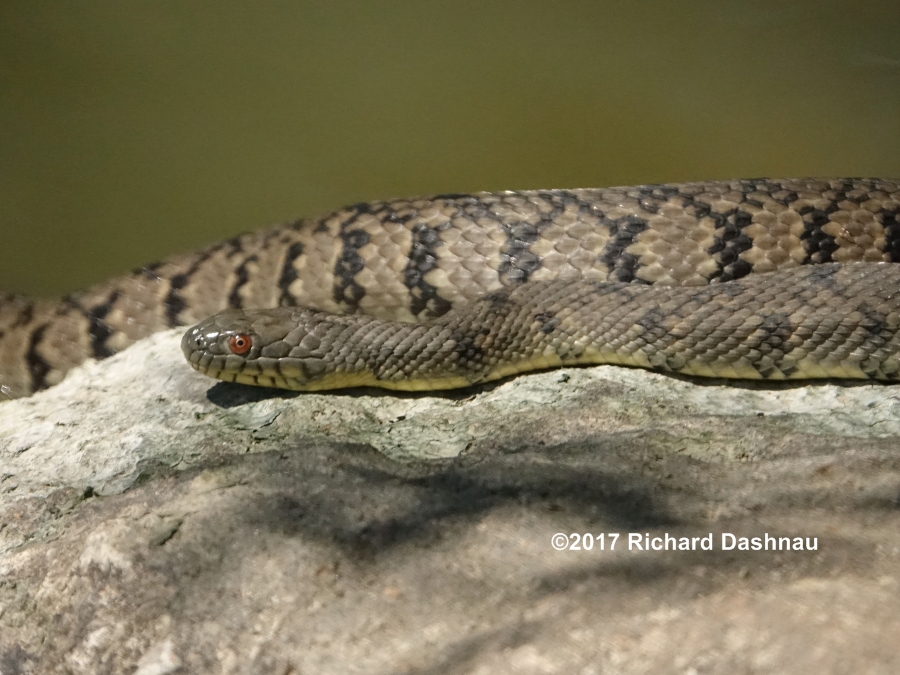
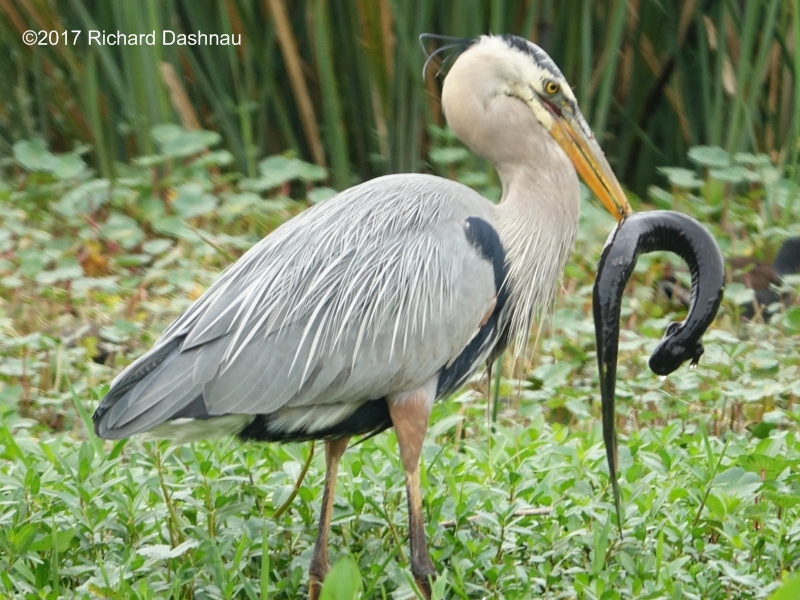
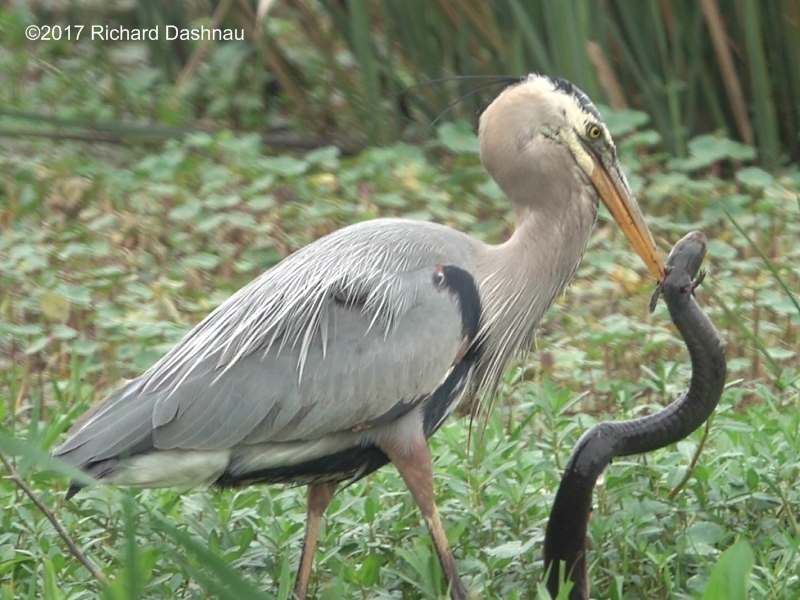
That
other animal is an amphibian. No, not a tadpole. A large salamander
that lives in Texas (I've seen them at Brazos Bend State Park) called a
Siren, or usually, a Lesser Siren. (Siren
intermedia). Sirens can
grow to 2 feet long (60.96 cm). There are two pictures above of one in
the jaws of a Great Blue Heron. They do have a flattened tail. But they
are totally smooth, and
they have two small front legs. The
carcass doesn't show legs, but they could have been torn off where that
damage is. Sirens also have large, exposed branching gills on the sides
of their
head. There are none here. I really doubt that the
carcass was a Siren, also. So, what does that leave us?
How about an American Eel? I think that this was
the
carcass of an American Eel
(Anguilla rostrata). They do live here, and I've found at
least one report online of one being caught in Brays Bayou.
I've
never seen one in the wild in Texas (or anywhere else).
01/13/2018
and 01/20/2018 . Various
species of the "tropical fish" known as Plecostomus have become
established in Texas waters. They are considered invasive and
destructive.
Since they have been living in these waters, it's reasonable to assume
that they have survived winters here. However, over the last few weeks
(specifically
from January 12 to January 20) we've had especially
cold weather. During the first week there were about 4 days of
temperatures around 30 degrees F. And during
the second week we had
about 4 days near 20 degrees F. While I was visiting Archbishop
Fiorenza Park on the 13th, I noticed many dead Plecostomus along the
banks
of the lake. On the 20th, most of the carcasses were gone
from where I'd seen them, but I did see Black Vultures eating a
few. I assume that the cold weather killed them.
The pictures
of the dead fish are from the 13th. I've taken a picture of my foot
near some of the carcasses for scale (shoe size 11). The pictures of
the vulture
are frame grabs from a short video clip. And the
video is here.
(NOTE 7/19/2020): The
fish in the pictures below are probably Pterygoplichthes species--but
still armored catfish.)
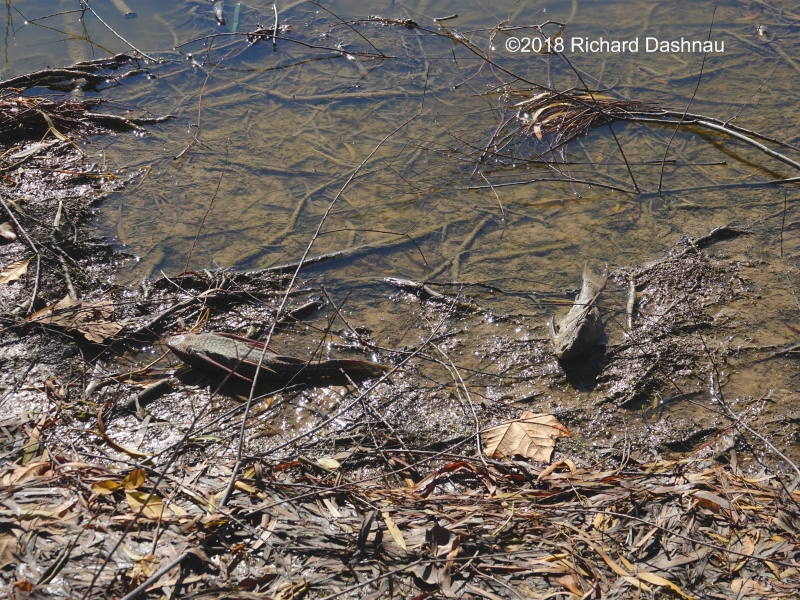
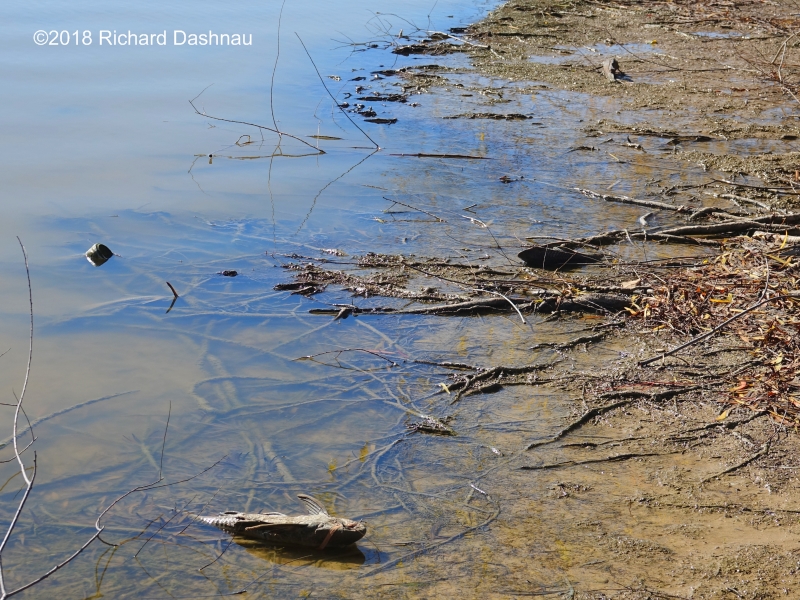
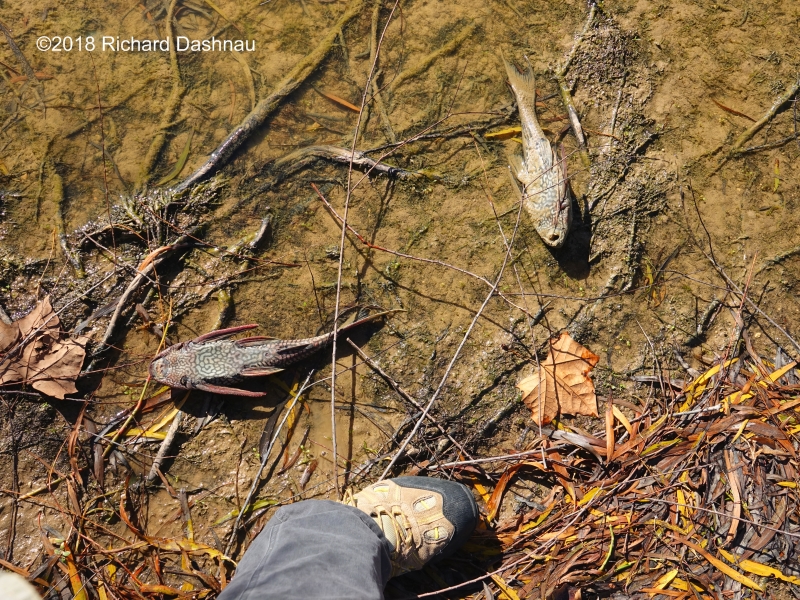
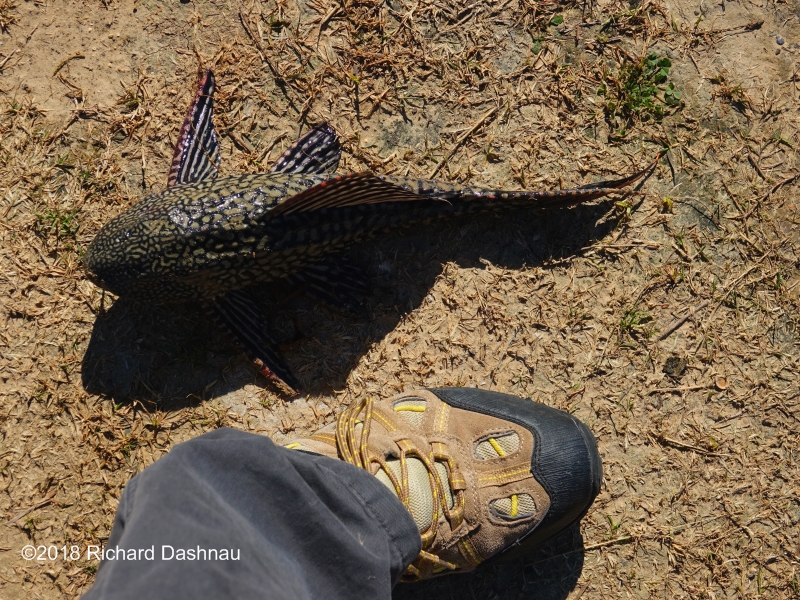
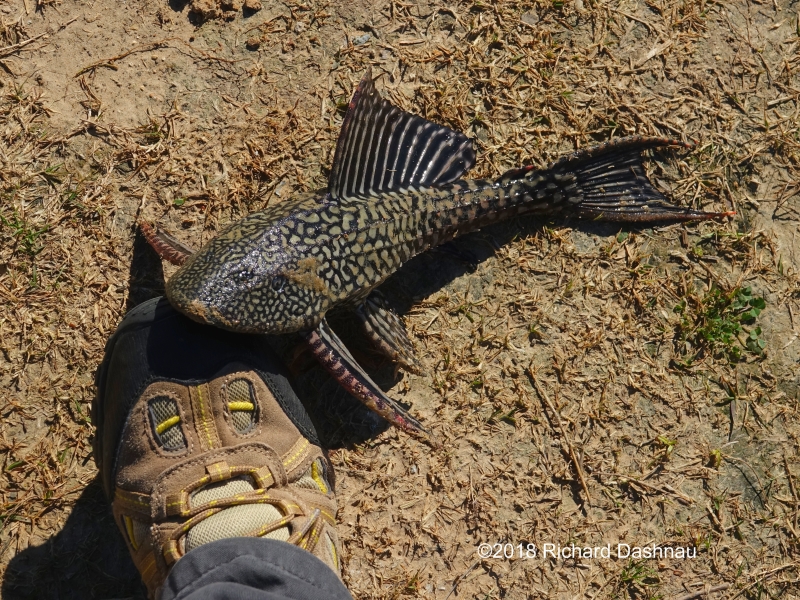
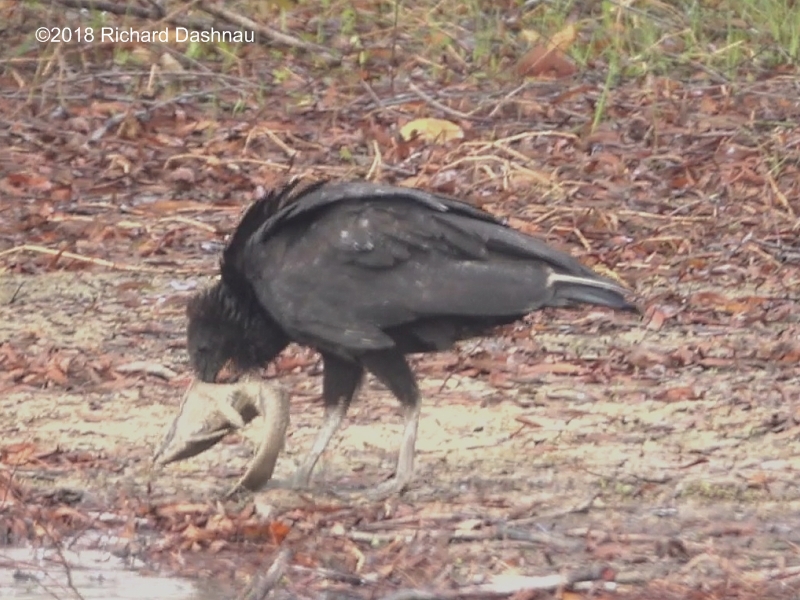
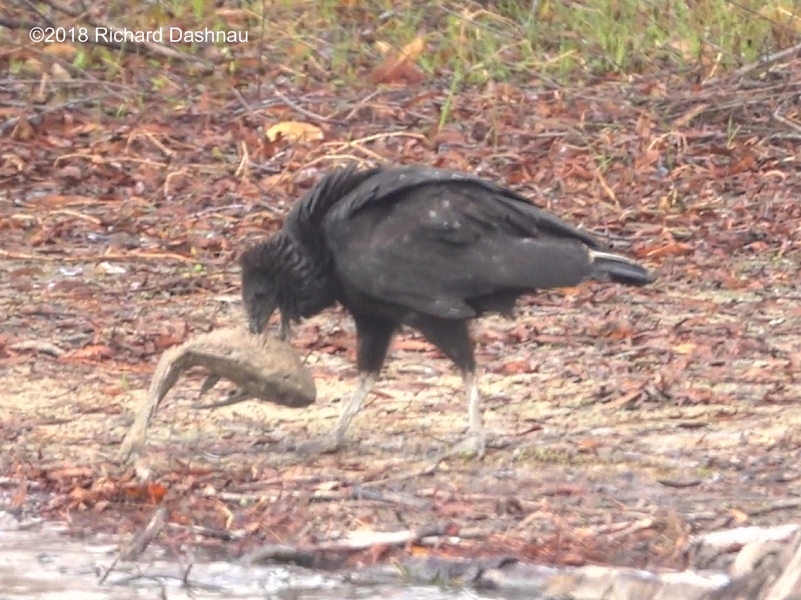
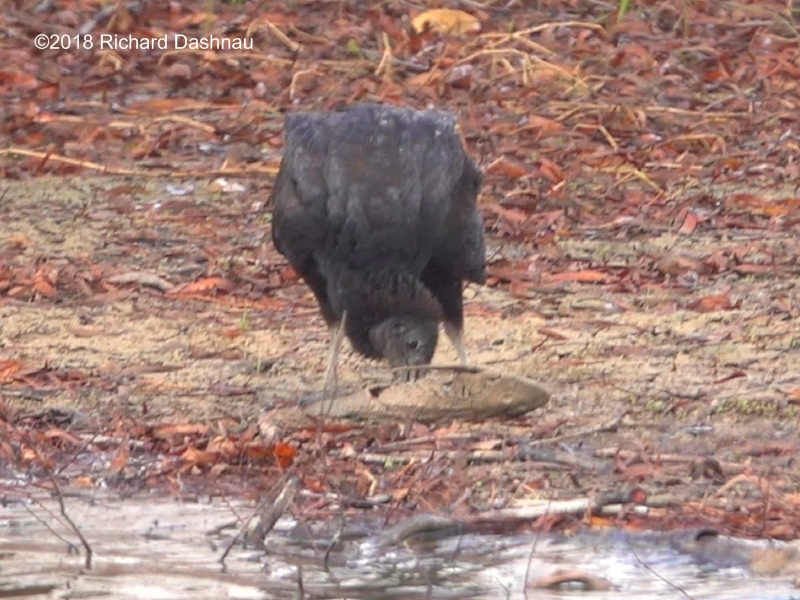
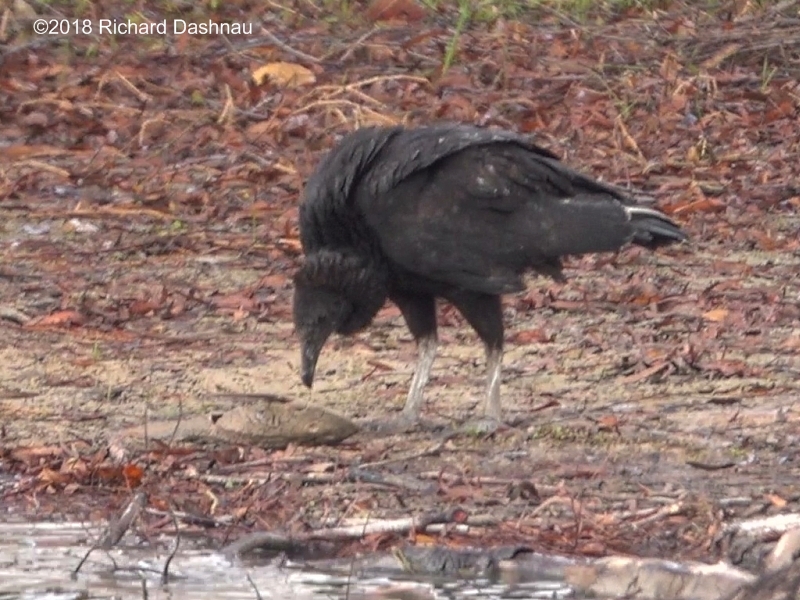
11/9/2015
Since
my investigation of the breaching fish, I've been looking through older
video footage and photos of gar that I've filmed over the years. I've
found a number of video clips
showing gar (mostly Spotted
Gar)gulping air. In all the older material, including the
Alligator gar I filmed this year, the breaching is not as active as it
seemed to be in the video that I shot in
September and October of
this year. I've added them to this page, but put them the chronological
order of the rest of the page. In the slow video, I can see a
consistent process which seems
to take the 3 steps I've also described further down the page:
1) The end of the jaws extend
out of the water and open briefly (perhaps with slight opening of gill
slits,).
2)
The jaws and head extend further out of the water, and the jaws and
gills slits open at the same time. A large quantity of gas is expelled
from the gills slits, making large bubbles.
3)
The head submerged, the gar begins to sink. The gill slits
open,
and a small amount of gas is expelled making a small stream of bubbles.
At this time, I don't know
exactly what is going on.
09/13/2015--10/11/2015
For some time this summer, fish have been "hitting" the surface of the
water in various parts of the park. I'd been watching this
activity near the Spillway Trail. There was a lot of fish hitting the
surface in Pilant Slough, from the Spillway west to the
Observation
Tower (distance about 900 feet, according to Google Maps). I had
assumed that most of the fish hitting the surface were Bowfin, and
possibly Gar.
I've observed both gar and bowin breathing air at BBSP before, and at
those times, the breaching was relatively sedate.
*These*
breaches were violent, sometimes spraying water for a wide area. And
the activity brought many alligators there to hunt the fish.
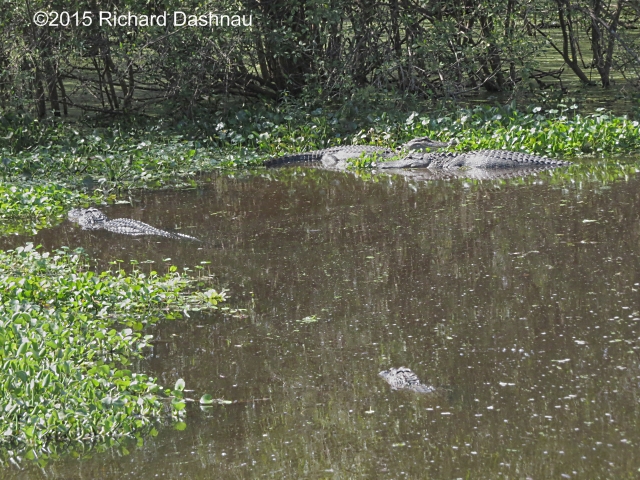
I started watching more closely starting in
September, where I determined that the fish seemed not to be hunting.
However,
the water was usually obscured by glare or by murkiness, so I could not
tell what kind of fish were surfacing. I was nearby when fisherman
successfully caught
both bowfin ( Amia Calva) *and* gar (both spotted (Lepisosteus
oculatus) and shortnosed(Lepisosteus platostomus).
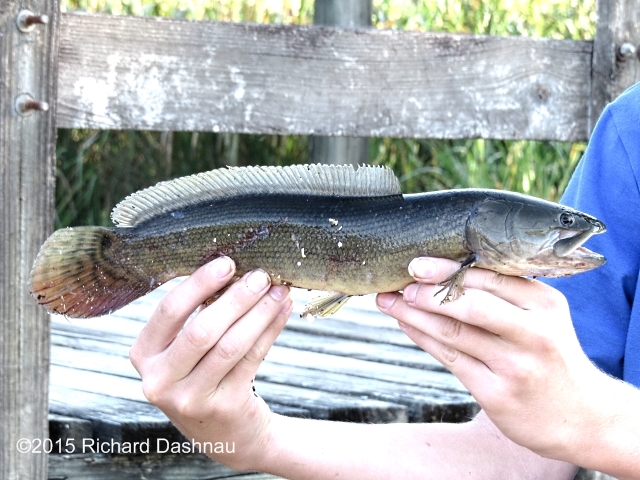
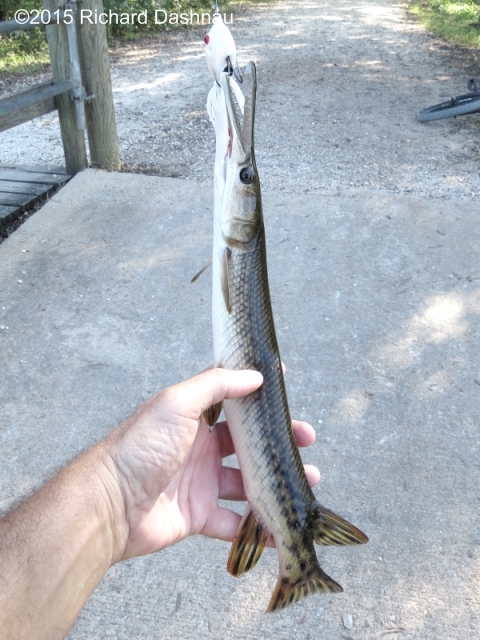
BOWFIN
SHORTNOSE GAR
It
seemed likely that these fish were the culprits, but I wanted to be
sure. So, I started trying to capture high-speed video of the breaching
events.
If I could capture an event at 210 frames per second, then I could play
it back slower to identify the fish. This was
a
bit difficult, but after 5 weekends (9/13/15 - 10/11/15), I caught
enough video clips to make some identification. I've put these all
together into one 5-minute clip.
I was able to identify bowfin in
some of the clips. Most obvious identity key was the long dorsal fin,
but the large blunt head and small pectoral fins were secondary keys.
Some of the other fish were gar; easily identifiable by the long, thin
snout. The clip is in 2 formats here(wmv) and here (mp4)
The animated gifs were made with frames
from the video.
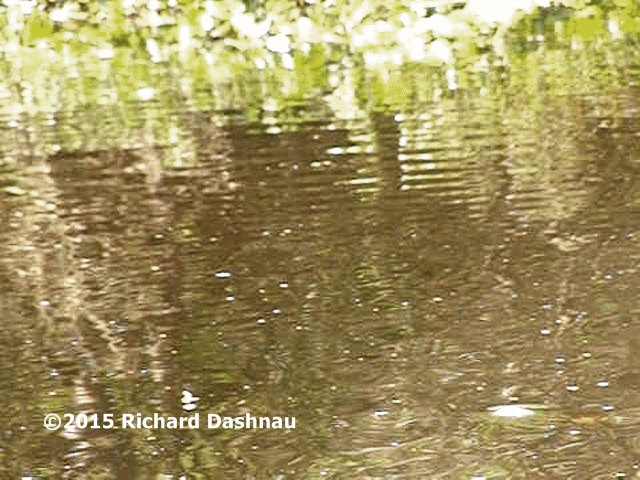
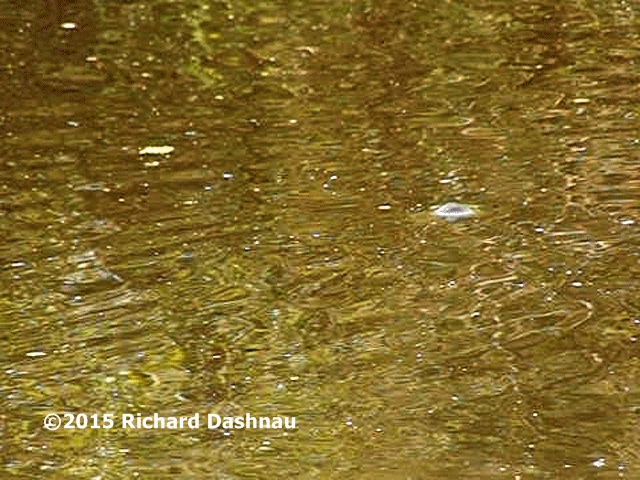
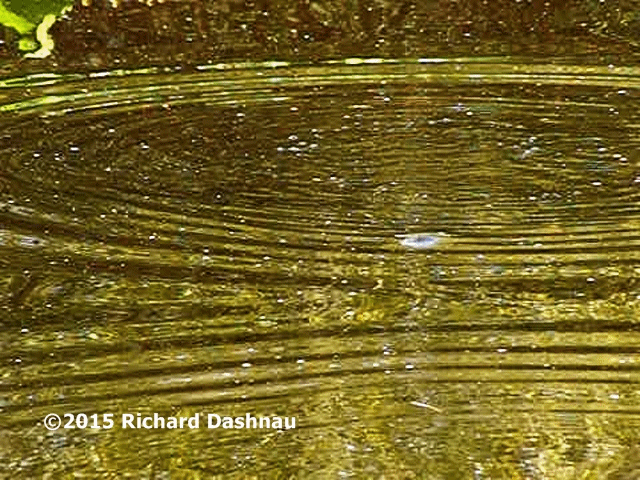
BOWFIN
BOWFIN
PLECOSTOMUS?
But, I saw a fish in a few of
the clips that I believe was neither a gar nor a bowfin. The fish were
usually dark, with a rounded head, but the pectoral and
pelvic
fins were very large-much larger than on a bowfin and closer together
than those on a gar. The 3rd gif above shows this fish.
I believe
that these fish are examples of plecostomus! I have found carcasses of
plecostomus near some of our local bodies of water.
Here's a picture of one that I took near Buffalo Bayou in 2009.
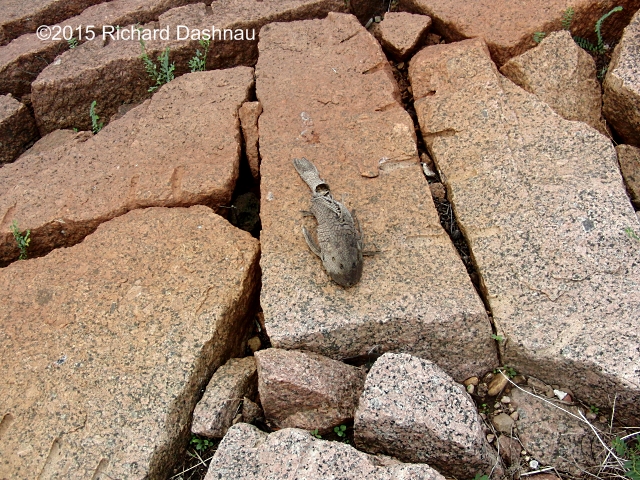
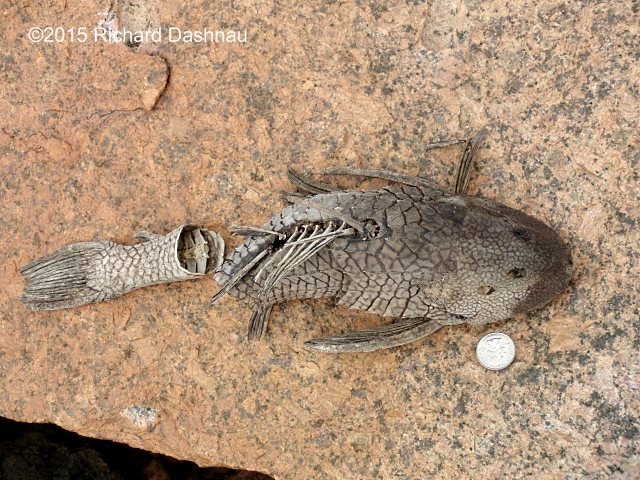

And here is a picture of a live one that I filmed today at a local pet
shop.
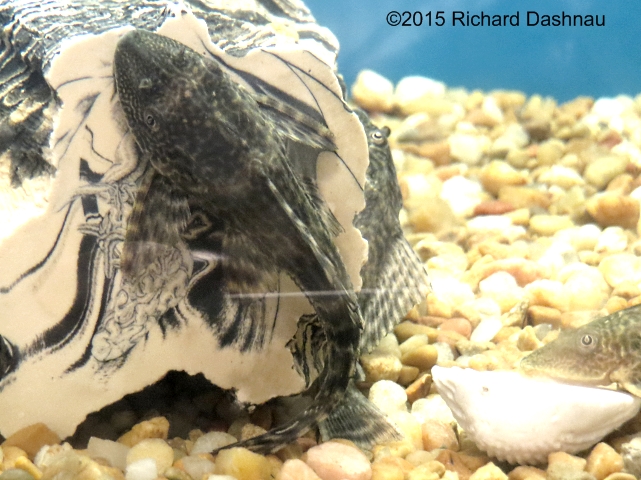
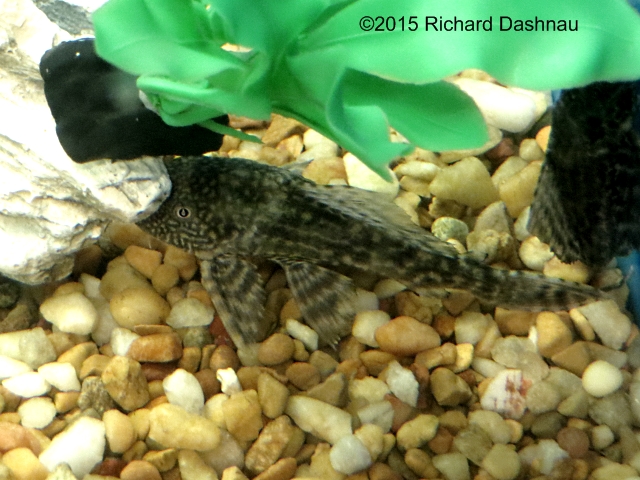
From
some research online, I have found that "plecostomus" can refer to
anumber of different species of fish. They are also known to surface
periodically to "gulp air",
possibly for bouyancy control. I haven't
seen anything that shows they use the oxygen. Gar and Bowfin are
related, and both have lungs. In some of the literature I've read,
these are called
true lungs.
In AIR-BREATHING DURING ACTIVITY IN THE FISHES AMIA CALVA AND
LEPISOSTEUS OCULATUS C. G. FARMER* AND D. C. JACKSON
Accepted 19 January; published on WWW 5 March 1998 it is stated that
lungs appeared in fish *before* swim bladders. (p.943) ;
During low-level exercise, more than 50% of oxygen used by both species
came from the air. Bowfin and Spotted gar.(p. 945)
and
on P.947 Increasing temperature increases the rate of air-breathing in
bowfin. Spotted gar also increase air-breathing with temp.
Air breathing may be more important to support activity than surviving
in hypoxic water. The fish CAN get O2 from air
if there is none in the water, but this situation happens less than the
need driven by activity.
In EFFECTS OF TEMPERATURE AND LIGHT ON AERIAL BREATHING BEHAVIOR OF THE
SPOTTED GAR,LEPISOSTEUS OCULATUS by
GERARDUS C. DE ROTH THE OHIO JOURNAL OF SCIENCE 73(1): 34, January,
1973.
Freshwater gars gulp air at the surface even at the highest levels of
dissolved Oxygen.Page 38.
In
another study, gar were obligate air breathers at oxygen lower than 4.5
ppm but active gar were obligatory air breathers at higher oxygen
concentrations. So, rising temperatures could
also cause more
surface
breathing. p39 (By definition water is hypoxic if it doesn't have
enough O2 to support life (< 2ppm)
http://toxics.usgs.gov/definitions/hypoxia.html
Normal is 8-10 ppm (parts per million)
May 24, 2015--
We'd been getting rain, and water levels have been good at the park.
Since it was wet this morning, I decided to drive down to Elm Lake.
When I drove over the floodgate
at the end of Pilant Slough, I looked
to my right--at where spillway that empties into Big Creek. What I saw
there made me turn around, go back to the parking lot at the VC, and
return with my
camera. The concrete spillway empties into a gully,
which empties after curving about 300 yards into Big Creek, which flows
past and continues out past Hale Lake and eventually into the
Brazos
River. But, at the spillway, the water is relatively calm,
and today
it acted as a sort of "lagoon". And there, in the calm water of this
lagoon, a large number of gar were swimming
around. From time-to-time,
the gar would come to the surface and--with a quick up-and-down of
their head--gulp air. I estimate that most of the gar
swimming around
were 12 to 18 inches
long. We have at least 3 species of gar in the
park--Short-Nosed Gar, Spotted Gar, and Alligator Gar. I was going to
try to see if I could see any Alligator Gar among those in the
collection.
Alligator Gar are separated from most other species of gar
by a few physical differences. One of these (and not easily seen) is
the *double* rows of teeth in their jaws. The other, is the
broad,
rounded shape to their snout. This broad head resembles that of an
Alligator--which is a reason for the common name. But, it is also
described in their taxonomic name-Atractosteus
spatula (nose broad and
flat). I watched in fascination as the gar moved about. I
tried a
few times to capture photos or video of them coming to the surface, so
I could get a view of the top
of their heads. It was hard to get these
views because the dark water prevented sighting of a gar until just
before it broke the surface. I wondered if I'd be able to identify an
Alligator Gar
among these foot-and-a-half long fish. But, before too
long, I had my answer. Through the circular ripples of the
moving
fish, I saw a looming lighter shape under the water. It made
its way
to
the surface like a submarine, and then broke the surface. As
the
head came up, water gushed out from the gill slits on each side. Then
the mouth opened, closed, and submerged. The fish
leisurely followed,
and took a while to fully submerge. The head was at least 8 inches
long...JUST THE HEAD. I'd found an alligator gar! Did I have the camera
ready? NO.
However, I continued watching. The large gar were
there among the others, and as time passed, I saw them surface many
times. I have no way of knowing if I was seeing the same Alligator
gar...or the same few gars. But some of them were immense. I could not
get close to the water, to get any certain measurement, but I think
some of the gar could have been around 8 feet long.
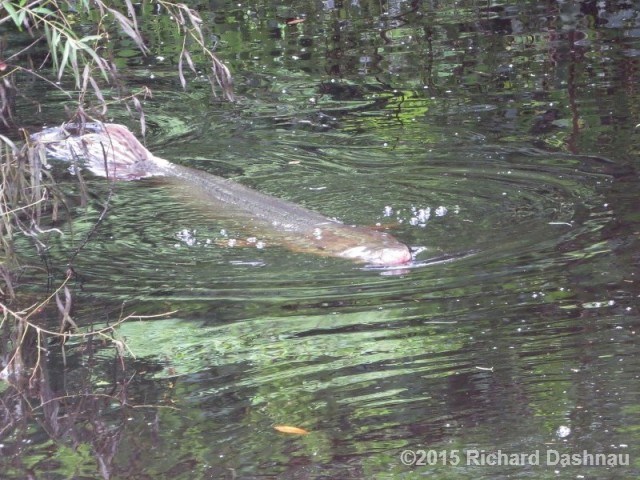
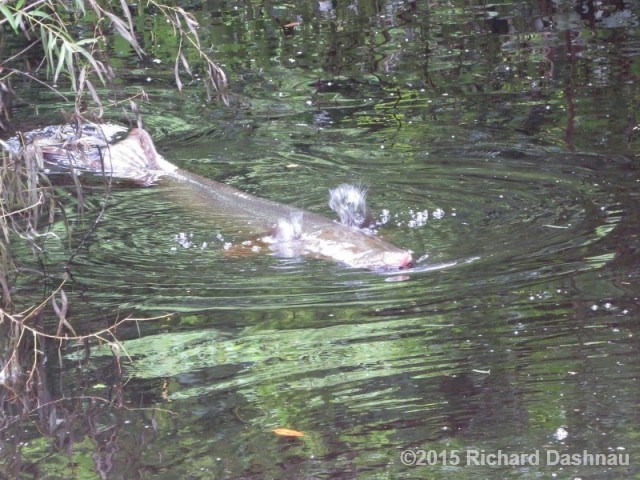
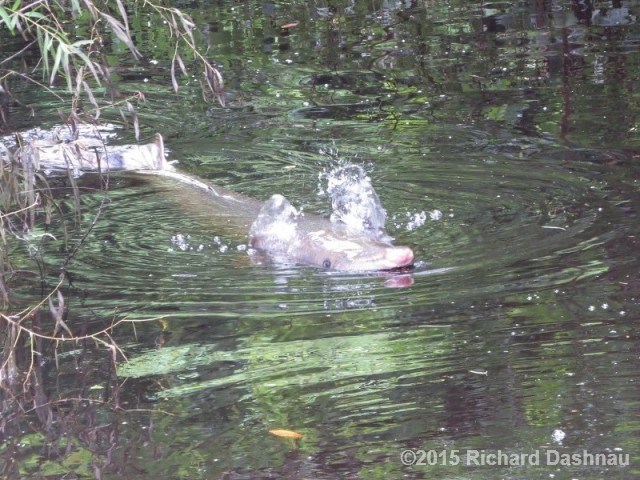
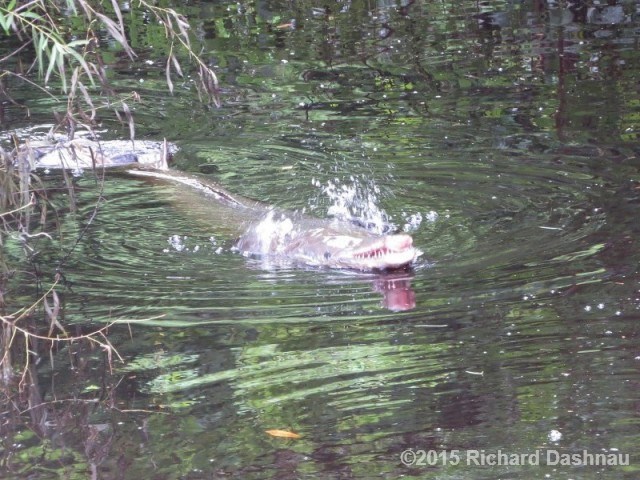
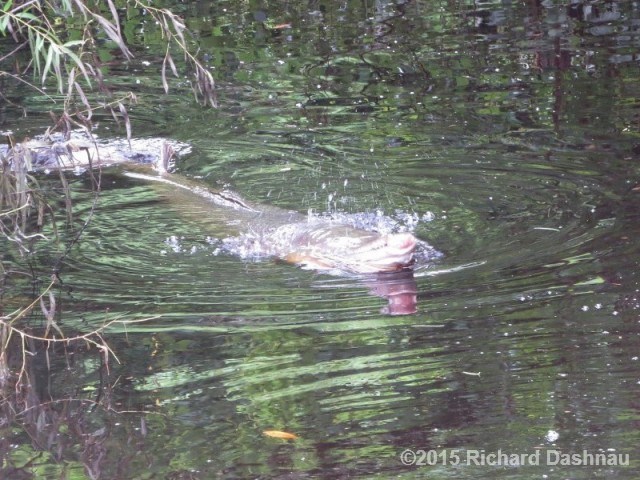

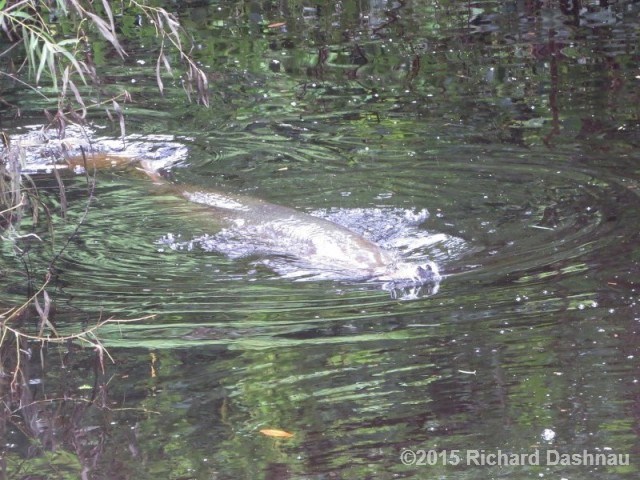
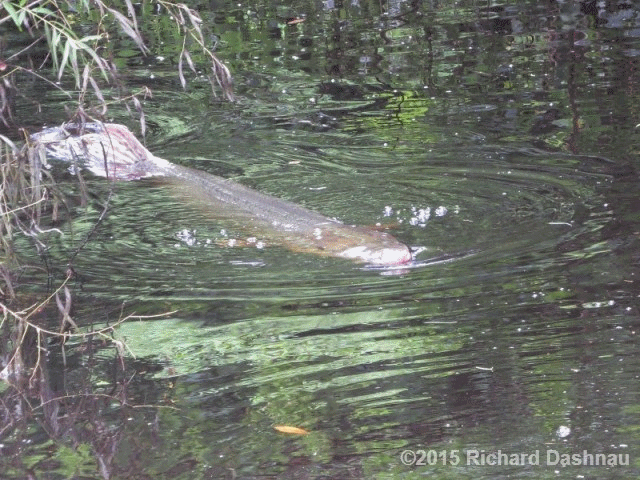
I
spent most of the day in that spot, watching those fish. I knew that
this was a transitory, and relatively rare event (we rarely get water
that high, in that spot), so I decided to make the most of it.
I
shot many pictures, and short clips, trying to capture some images of
those huge fish...and trying to get some footage that could give some
sense of how large they were.
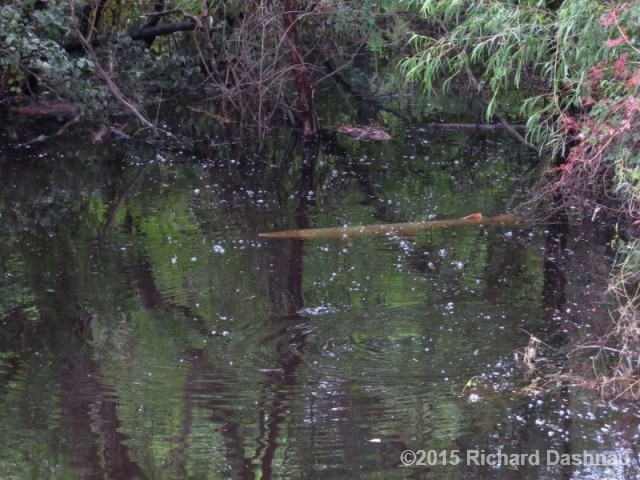
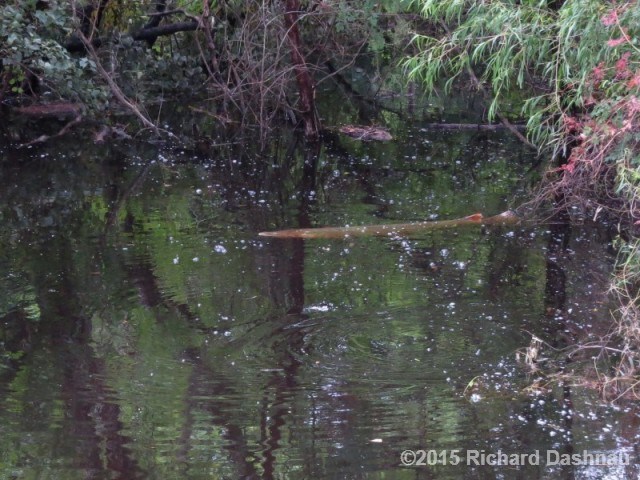
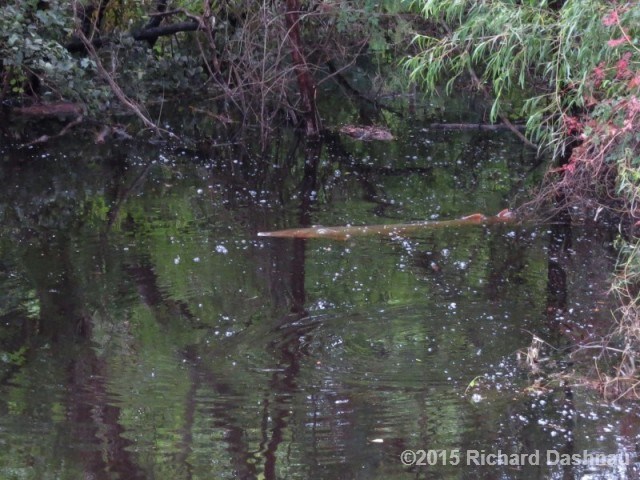
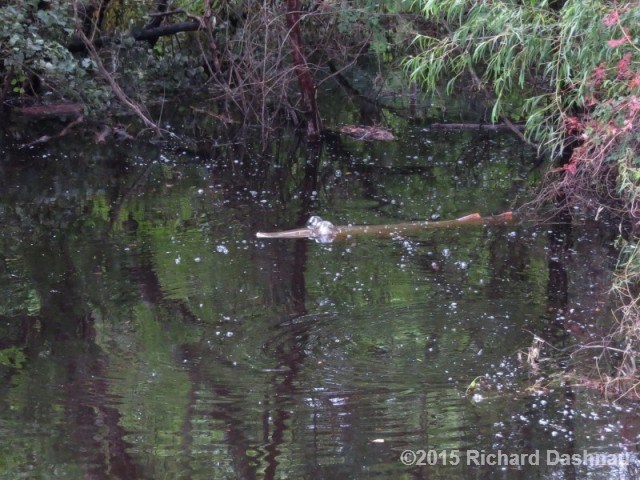
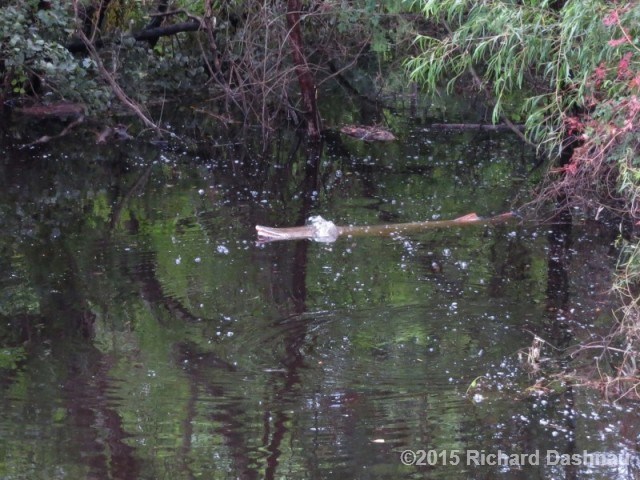
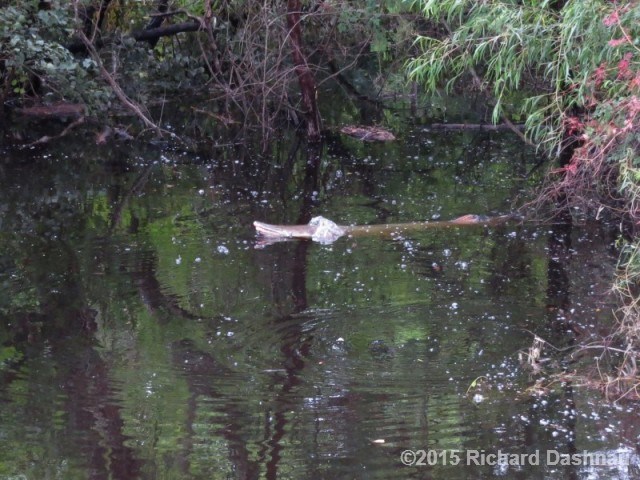
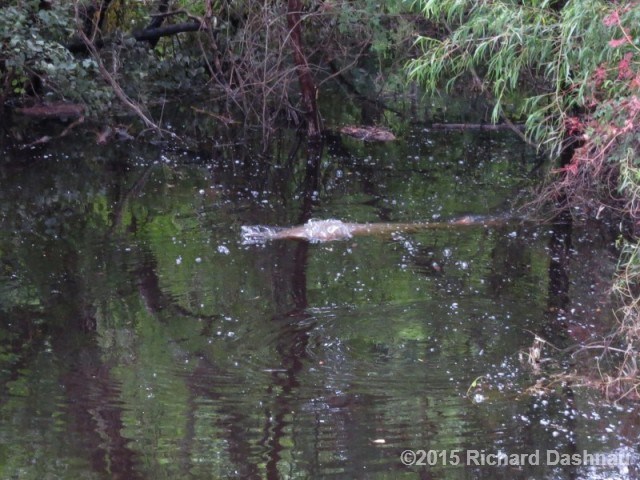
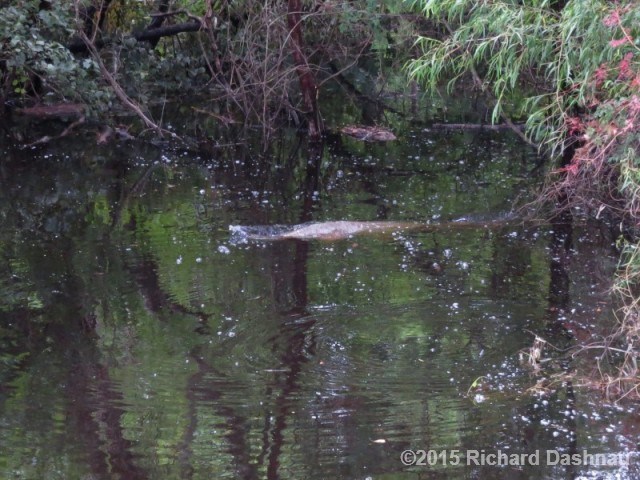
I
didn't see anything that looked like feeding behavior. I didn't see any
chasing, I didn't see any "bait" fish. I *did* see what seemed to be
gar swimming in pairs--and a few times one surfaced,
and another
surfaced right behind it. All the splashing and activity
finally
attracted our other large aquatic predator--the Alligator Gar's
namesake. An alligator appeared from Big Creek. It
was about 8 feet
long, and moved leisurely towards the spillway. It encountered a stick
about 5 feet long, and just pushed it along.I happened to be shooting
video, trying to get some scale to
the scene. As I was filming, the
alligator suddenly leapt up and forward. It had gone for one of the
surfacing gar, but missed. The alligator moved back among the wooded
cover, and I lost sight
of it. I watched the gar until it was time to
go home. I've made two short video clips from some of the
footage.
This clip was edited from footage shot at normal speed
(30fps). The
alligator
also appears in it: Alligator
Gar 05242015 (mp4 format) The
second clip is made from footage shot at 120 fps, and played back at
30; for slow-motion. These show the Alligator Gar
gulping air at the
surface. Unfortunately for me, while the camera was adjusted to lower
light to "see" the fish under the surface; when the fish came out of
the water, it was overexposed
photographically. I tried to adjust this
with software. The slow motion clip is: Alligator
Gar 05242015 slow (mp4 format)
I'd
never encountered anything like an Alligator Gar until a dead one
appeared in the spillway (not the same spillway we have now, but in the
same spot) in 2002. I was able to salvage the
skull from that fish, and
I used it to prepare the exhibit that's in the Visitor's Center
now.
That skull was about 12 inches long, from snout tip, to the rear of the
head. The carcass-when I finally
found it-was as long as one of our
John Deere gators; about 8 1/2 feet long. Since 2002, many things have
changed. The internet has changed, and perception of the Alligator Gar
has
changed. The story of the gar in 2002 can be seen on further
down on this page. Alligator
Gar (Atractosteus spatula) have been a reviled, misunderstood species
through much of its natural
range. So much so, that its natural range
has dwindled over the years. Texas is one of the few states with a
remaining healthy population of Alligator Gar, and TPWD has been
studing this
fascinating creature to better understand it. That wasn't
the case in the 1930's when a man named J.G. Burr created "The
Electrical Gar Destroyer" and began using it in various bodies of
water. Others emulated him, and thousands of gar were killed (from what
I could find, there is no mention of how many other animals died along
with them). But, things have taken a turn for
the better, and now much
more is known about them. One important fact is that it can
take
40 years for a gar to grow to 8 feet long. Another is that Alligator
Gar can only spawn when certain
circumstances occur: there must be
ground flooding, and the temperature must be correct (at least
68degrees). I believe that I was watching courtship or
spawning
today--especially when a
pair of gar would surface. As I mentioned,
Alligator Gar have 2 rows of teeth in their upper jaws, with the 2nd
row in the roof of their mouth. They have a "vascularized" swim
bladder--which
they can use to collect air and then get oxygen from it.
Their skeletal system has a combination of bone and cartilagenous
features--a sort of crossover from skeletons of sharks and those of
true "bony" fish. Gar are covered with thick, strong ganoid scales.
They are opportunistic predators, and hunt many types of smaller prey,
but most often eat "forage fish" like gizzard shad.
Claims that they
decimate populations of game fish (such as bass) have turned out to be
unfounded. Ongoing genetic studies have shown Alligator Gar to be most
closely related to Bowfin
(Amia calva).--which ALSO live here in the
park. Alligator Gar are not only big, but very unique fish.
And....they are just one of the creatures that live here in our park.
And I got to watch a
group of them swimming freely right here.
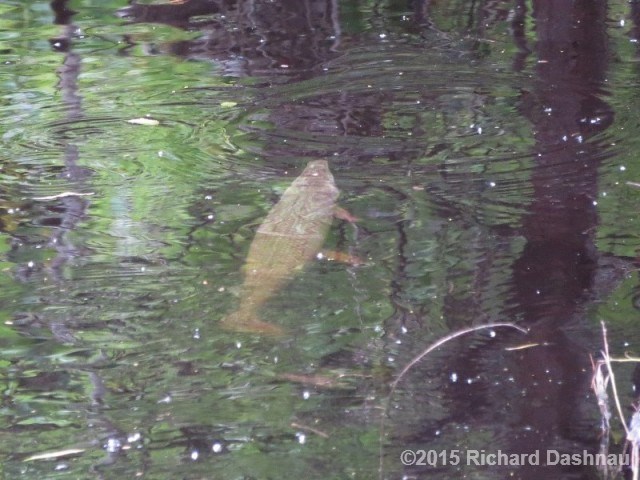
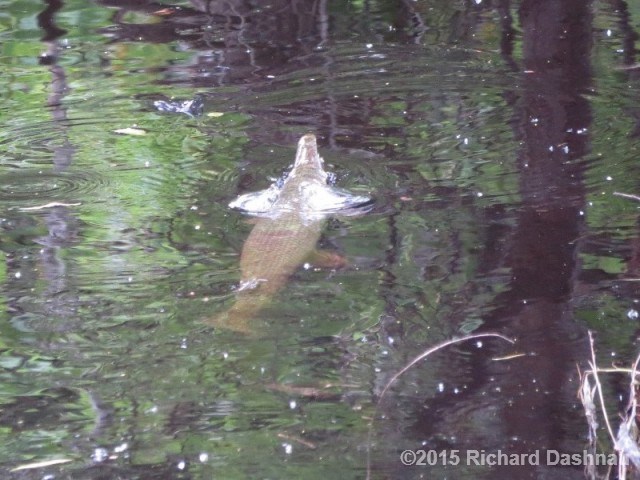
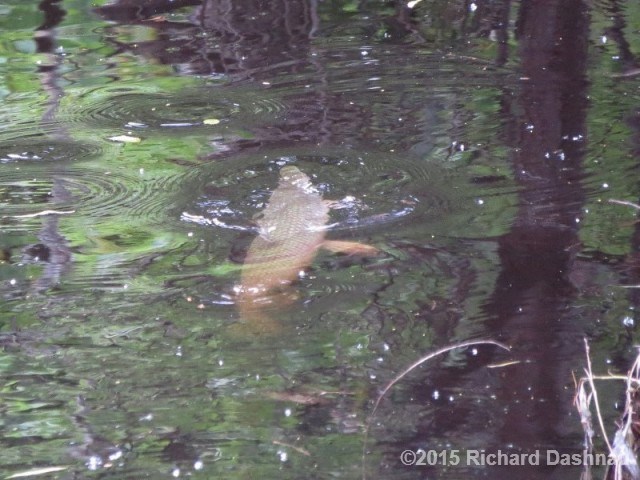
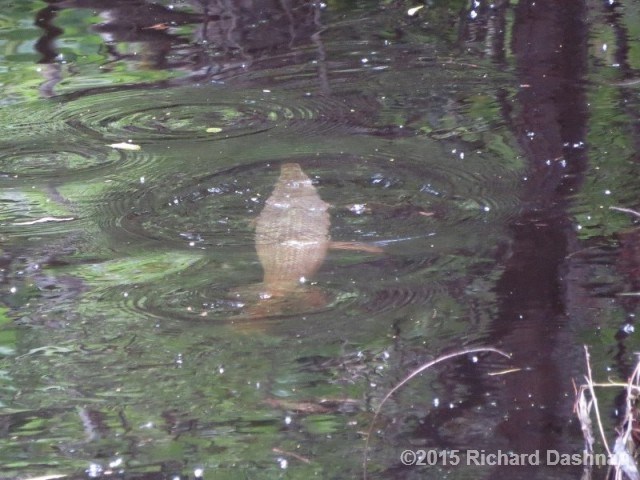
Here
are some good links to information about Alligator Gar:
This article in Texas Parks magazine: http://www.tpwmagazine.com/archive/2015/mar/ed_3_gar/index.phtml
The general description on the TPWD site: https://tpwd.texas.gov/huntwild/wild/species/alg/
and another page here: http://www.fishesoftexas.org/taxon/atractosteus-spatula
There are many other pages, but these were related to fish in
Texas.
July
24, 2011 (added 11/09/2015) And
another
week later, and the Spotted Gar are still moving around. I continued
shooting high-speed video, hoping to catch some hunting activity.
I
still didn't see any. I did get another clip of breathing. I've
manipulated this clip to show how quickly this happens, and also to
slow it even more.
The 10 images below are frame grabs from this
video
clip.
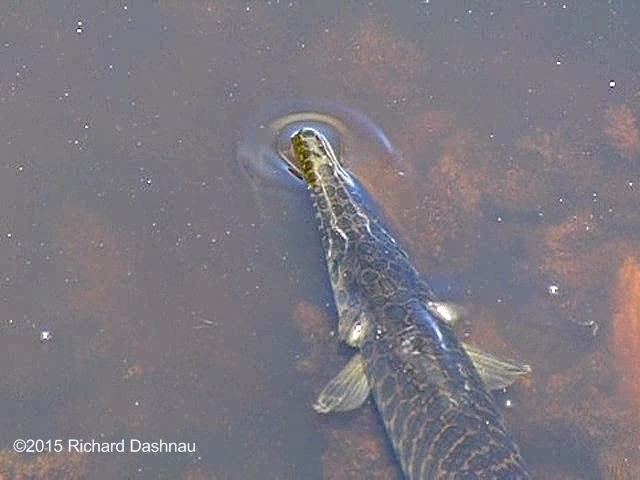


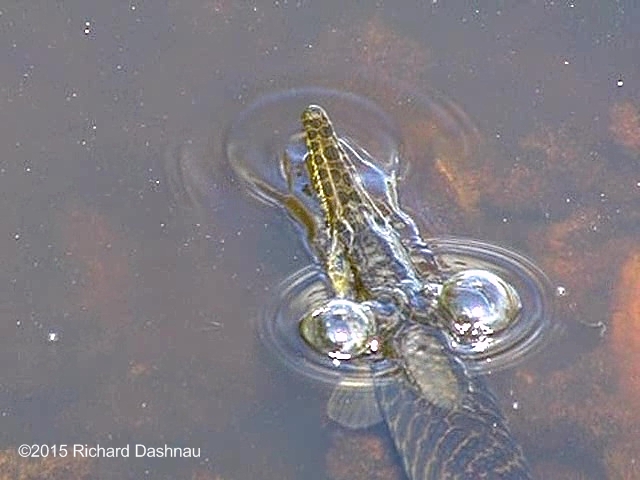
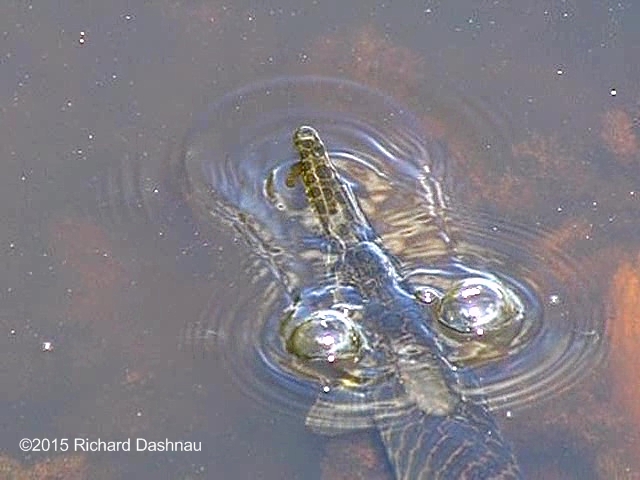
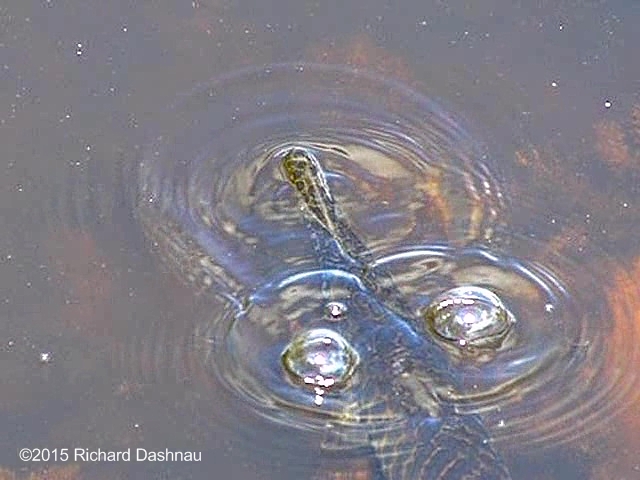

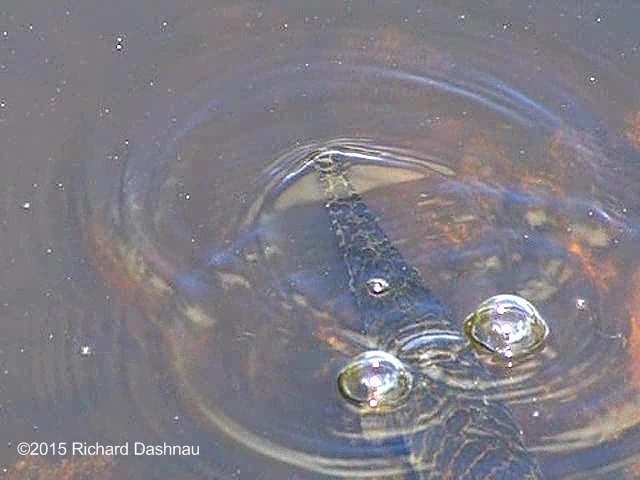
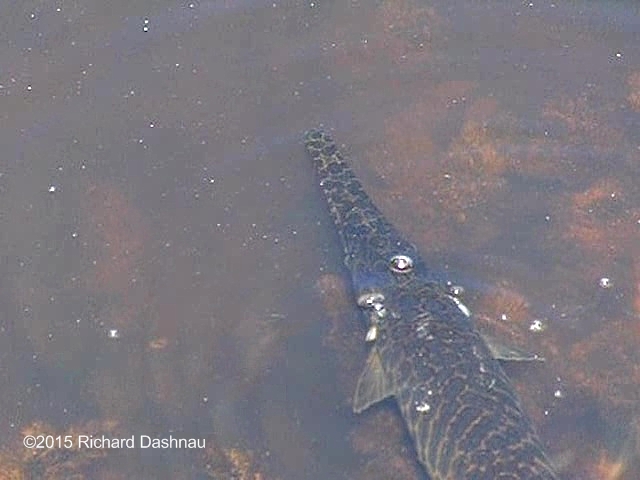

July
17, 2011 (added 11/06/2015) A
week later, and the Spotted Gar are still moving around. I continued
shooting high-speed video, hoping to catch some hunting activity.
But,
I didn't see any. I did get a few more clips of them breathing.
This seems to be a 3-step process. First, the tips of the
jaws
break the surface and open briefly.
Next, air is expelled from
the gill slits--usually in large bubbles. Then most of the head breaks
the surface, and the jaws open and close again before the head
submerges.
As the gar sinks after this, a small trickle of bubbles leaks
from the gill slits. the 10 images below are frame grabs from
this
video
clip, which shows 2 surfacing events.

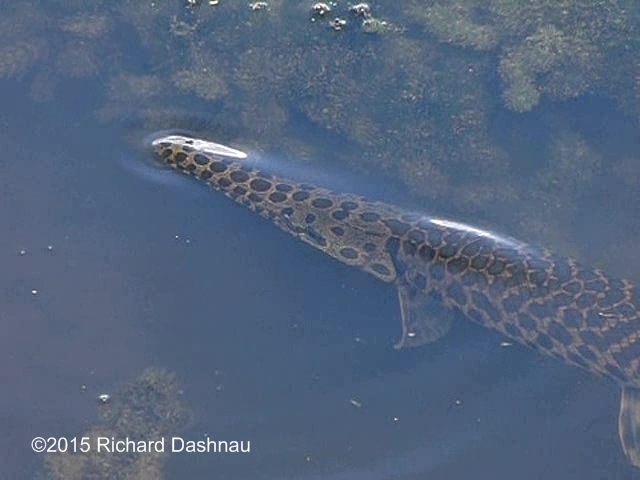
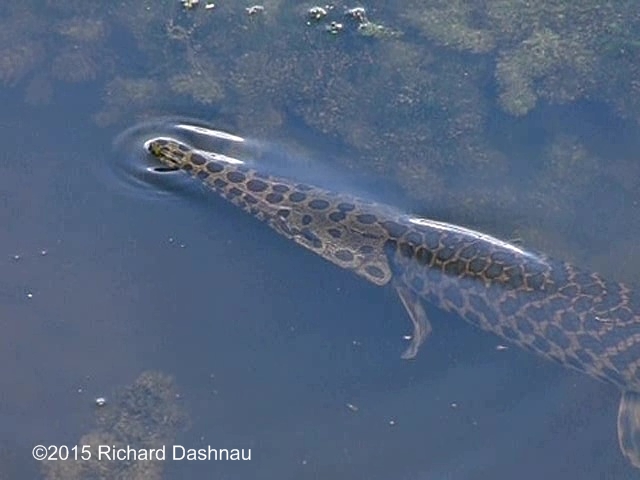
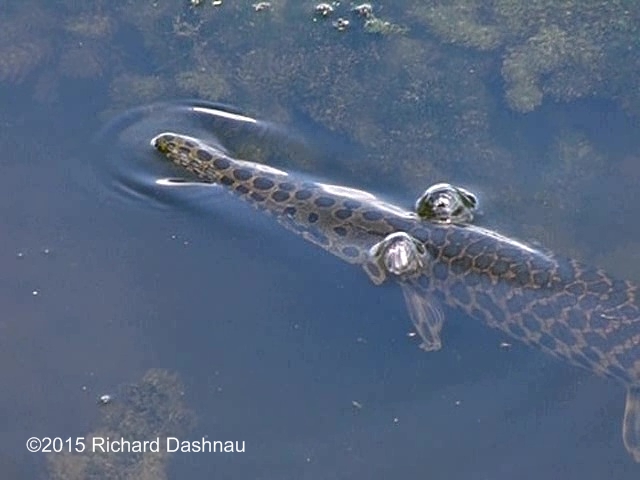
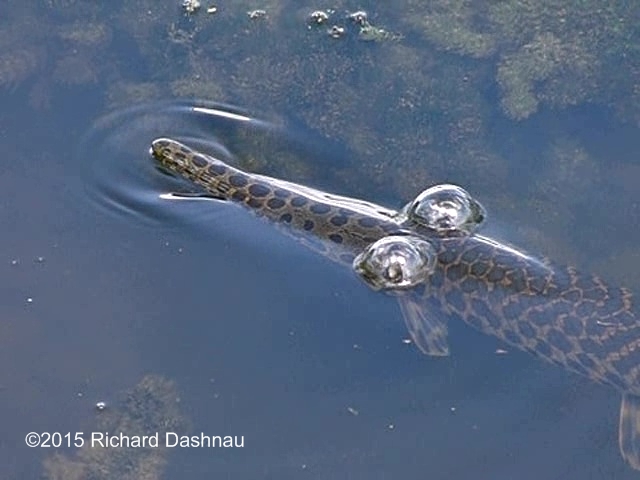

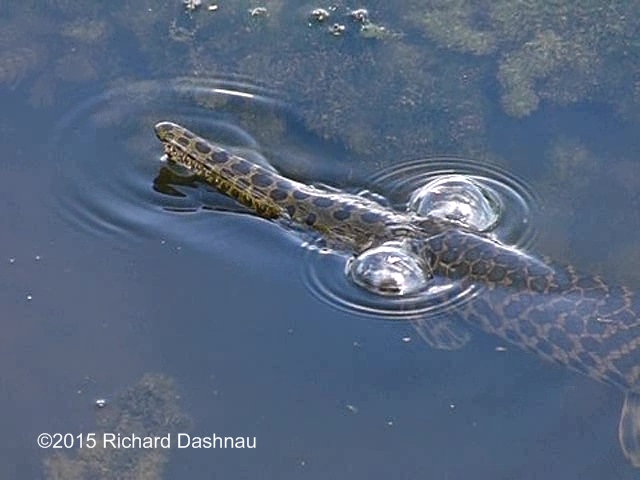
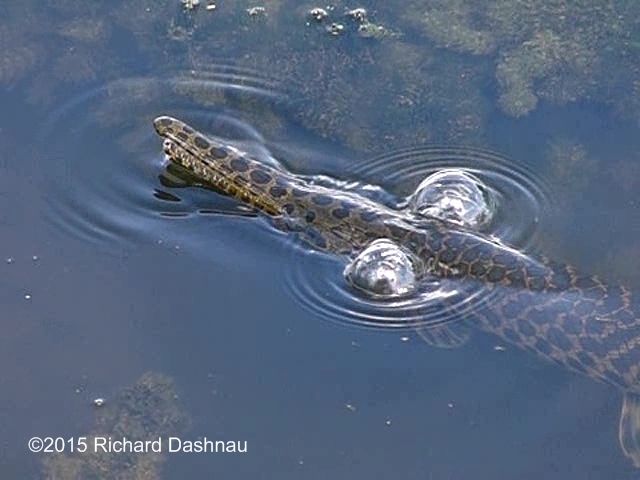
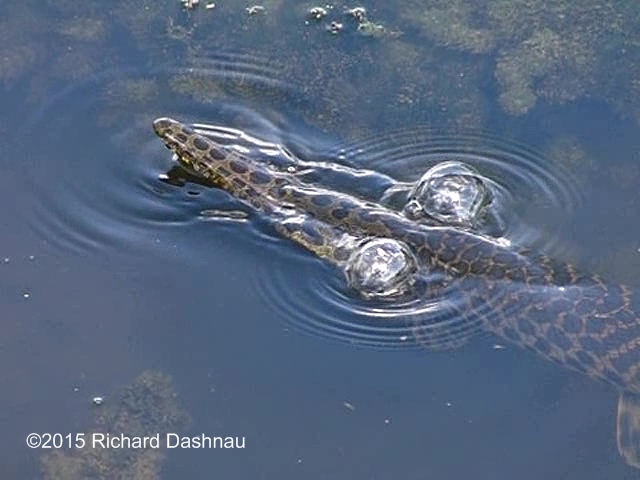
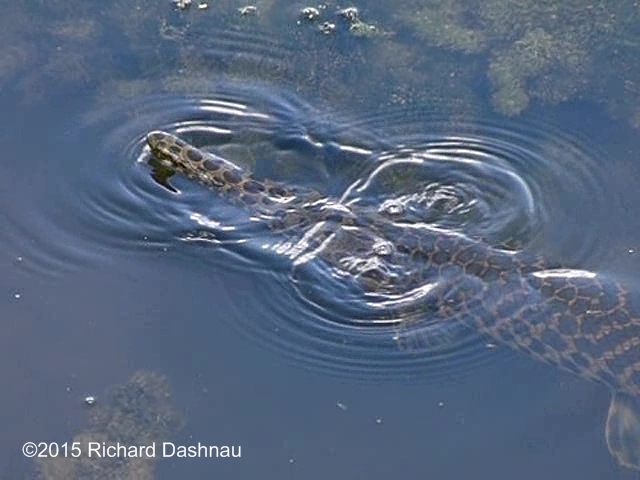
July
10, 2011 (added 11/03/2015) Gar
and Bowfin are distantly related, and both can breathe air. On this
day, I was able to see Spotted Gar (Lepisoseus Oculatus) and
Bowfin swimming near each other. The three images below are frame
grabs from this video
clip. The gar gulps air once in the clip.
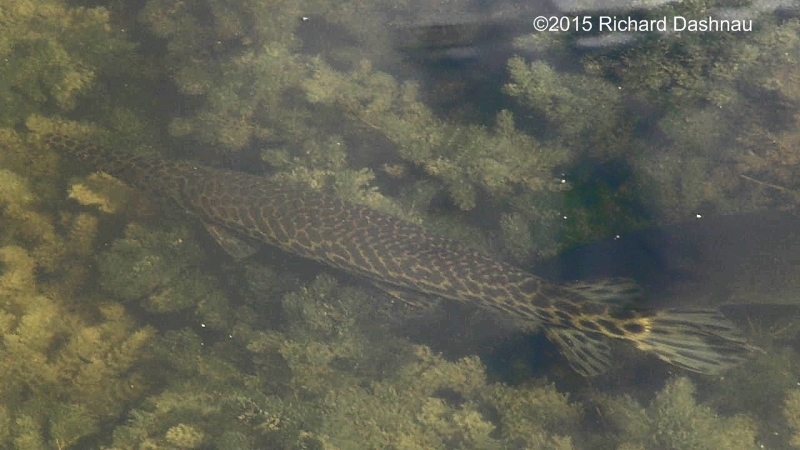
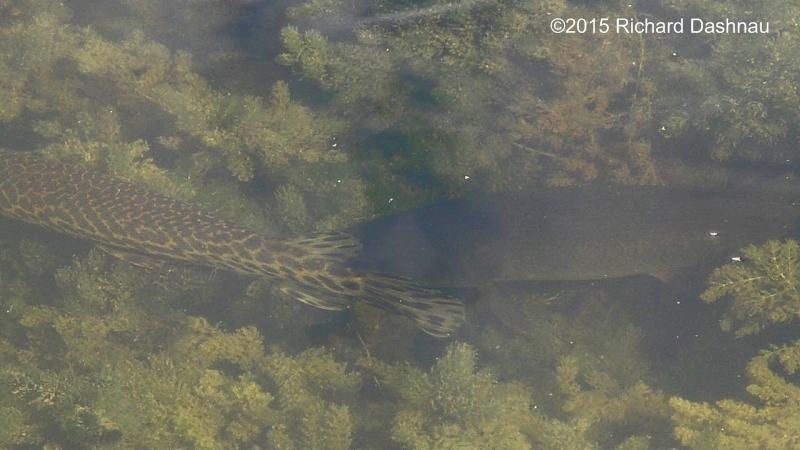
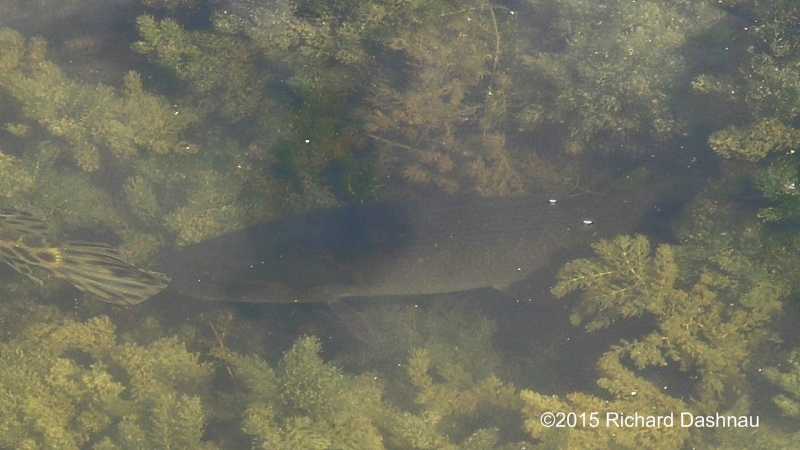
May
3, 2009 (added 10/31/2015)(updated 1/21/21) I
watched this gar swimming in Elm Lake, and was able to film it taking a
gulp of air--at 210 frames per second. The images below are frame grabs
from this video
clip(mp4)
This is how I usually see gar coming up for air. They slowly approach
the surface, then tilt their jaws out of the water, open them-then air
seems to flush through
the gill slits, and the gar slowly sinks under.
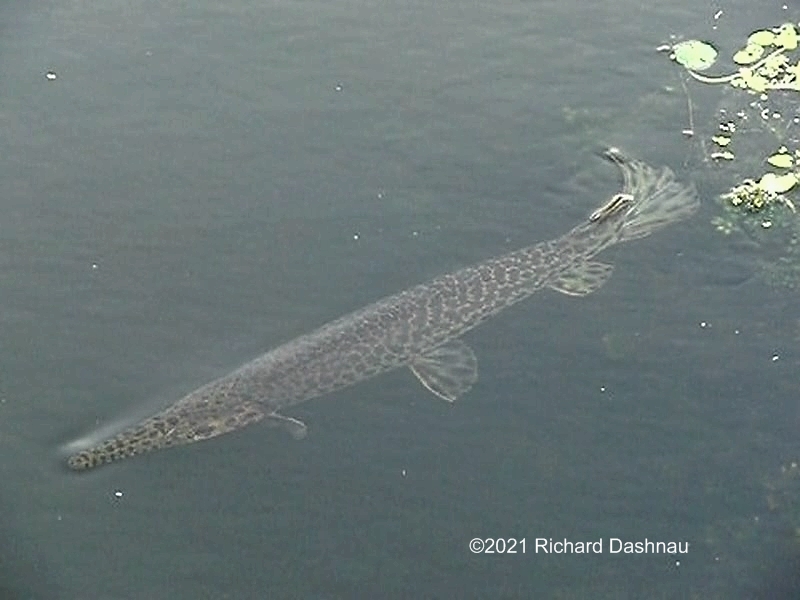
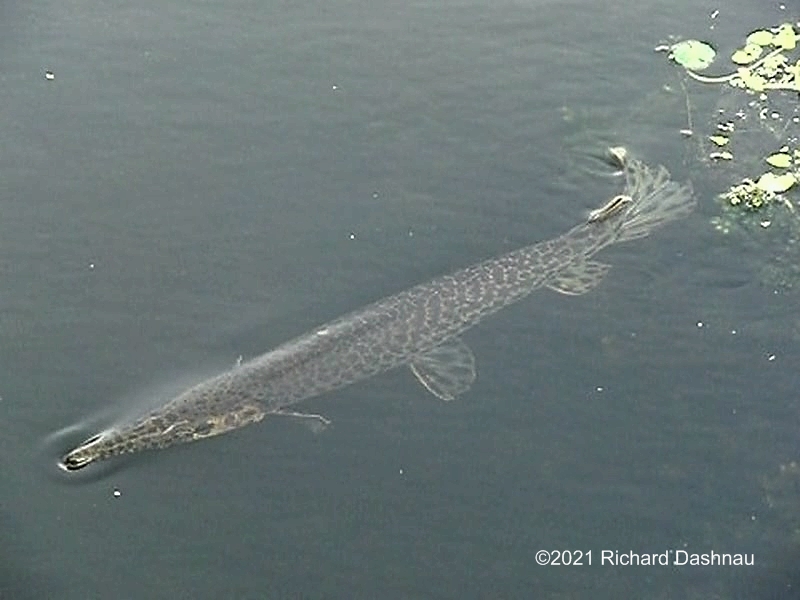
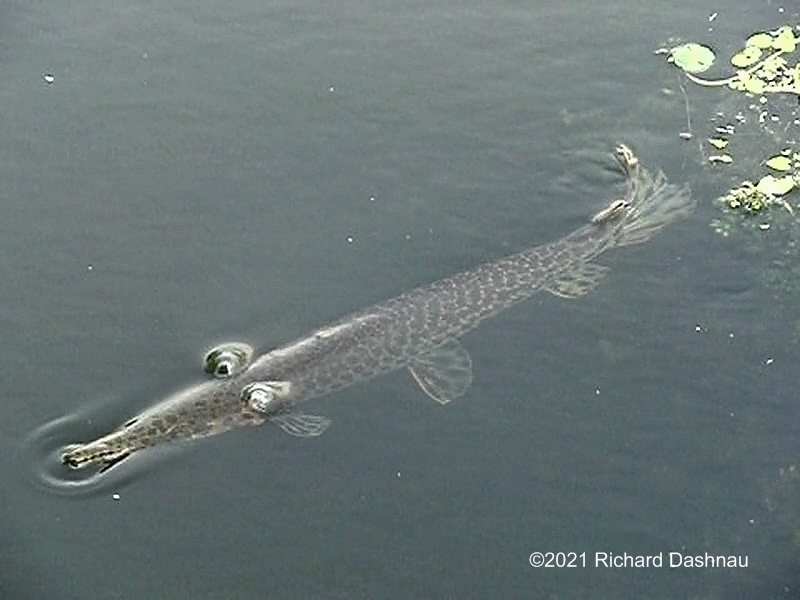
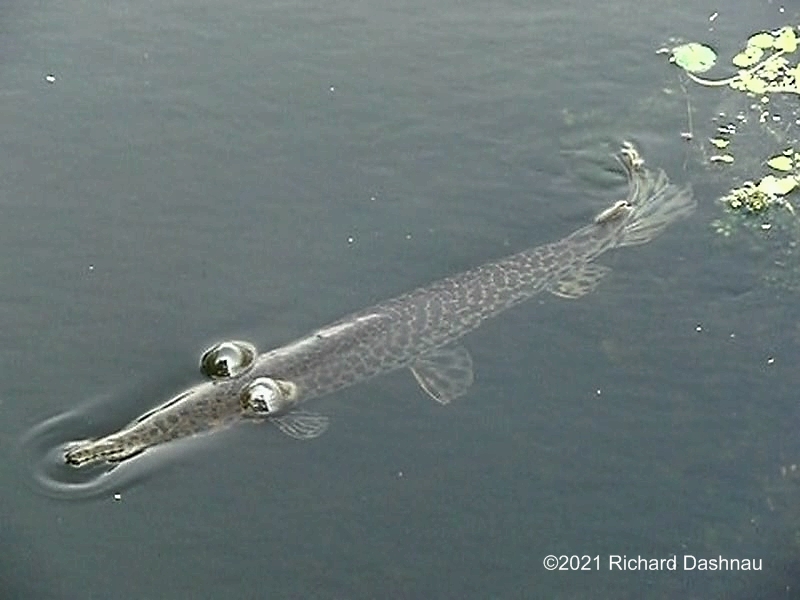
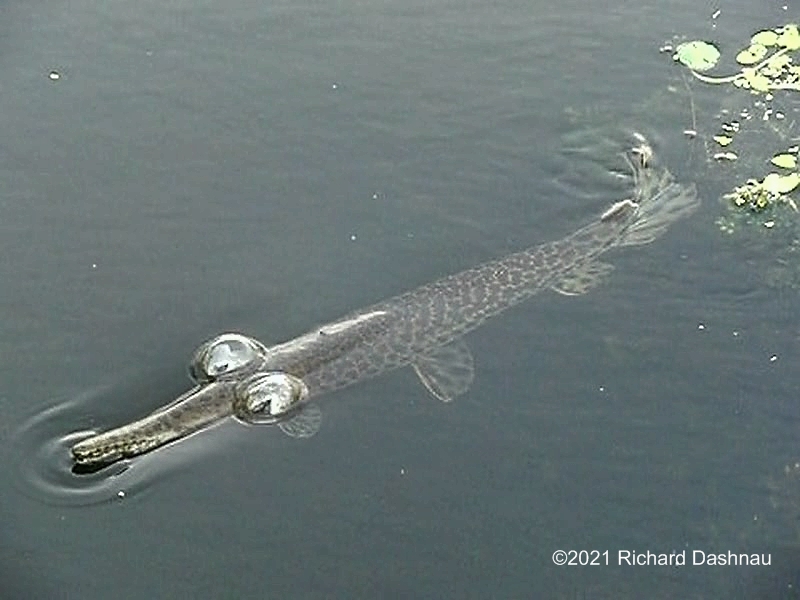
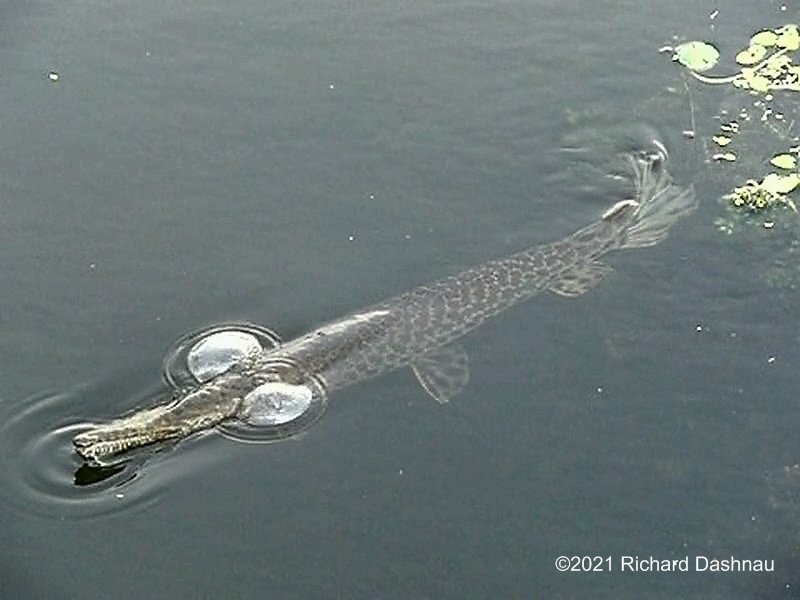
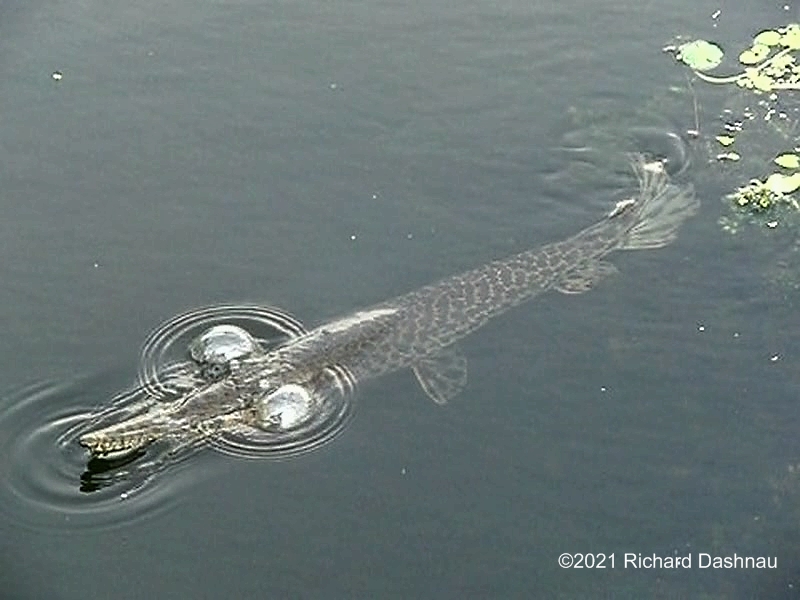

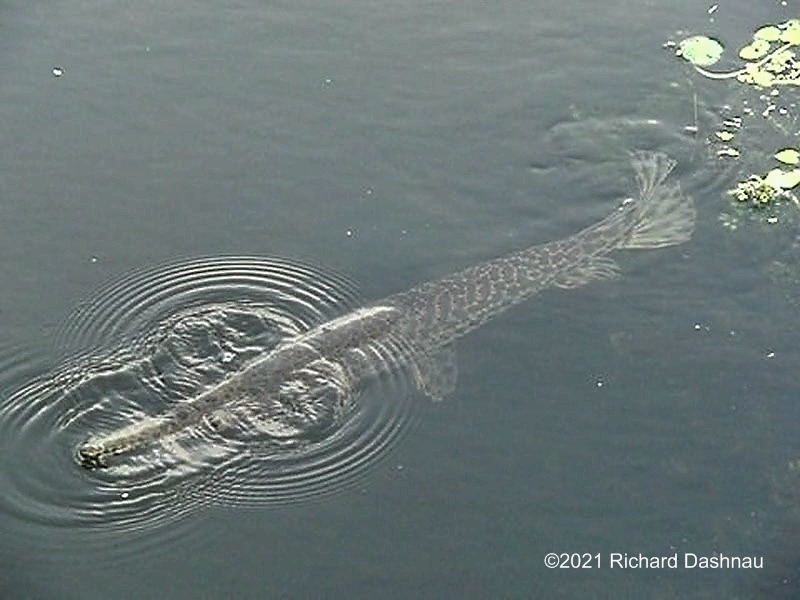
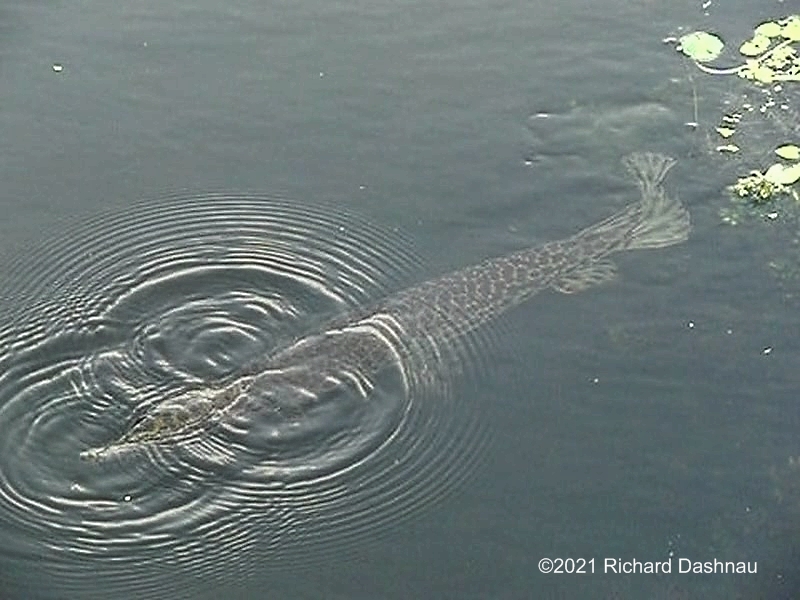
November
10, 2002The
image below (BOWFIN) is of an interesting "primitive" fish called a
"Bowfin".
The
water at the park got very high. In fact the nearby Big Creek was so
filled
that the water from Pilant Slough, which normally flows out of the
park,
was flowing back INTO the park from Big
Creek. As evidence of the amount
of water we received, here it the fishing pier on Hale Lake, the deck
of
which usually stays at least 10 feet above water level (see HALE LAKE
PIER,
below). This happened for about 2 days, until the water level
dropped
in Big Creek . As the water started flowing back out of Pilant Slough,
other bodies of water were free to drain. 40 Acre
lake started flowing
back under the footbridge, and a few predatory fish stationed
themselves
in the sluggish flow. Among them were a few Bowfin, and a few Spotted
Gar
(see image below).
These fish were about 15 inches long. It is interesting
to me that these "primitive" fish both inhabit the park, right along
with
various perch, sunfish and bass. Of course, let's not forget
the
Alligator
Gar! The image below (HEAD AND SPINE) shows my completed gar as it is
now.
-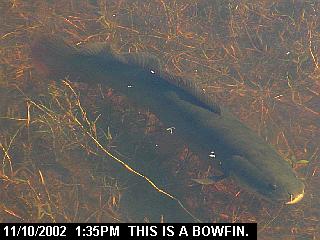 -
- -
-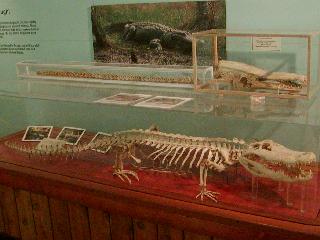 -
-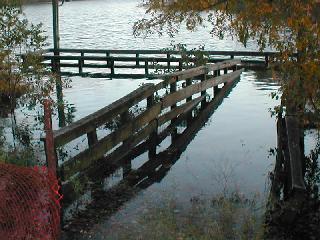
BOWFIN
SPOTTED GAR
GAR HEAD AND SPINE
HALE LAKE PIER
October
20, 2002A
rather cool, wet weekend. However, on Sunday, some alligators showed
themselves
right after the sun finally came through the clouds. On
Saturday,
we had the
Volunteer Picnic at the park. During this, I'm proud to say,
I received an award for "Outstanding Volunteer" from the Brazos Bend
State
Park Volunteer's Organization. Apparently, this was
due to votes cast by
a number of volunteers. Thanks, everyone! I have a great time doing
things
at the park, and then I GET AWARDED FOR IT! Is that great, or WHAT? The
image below
middle (RICKUBIS LIKES FISH) shows some older guy,
Rickubis(yes,
that's me), attempting to reconstruct the spine of a very large
Alligator
Gar--on the dining room table. In fact, this is the
same gar I've talked
about before. So far, I've gone out on three occasions to dig
and
scrape and find these vertebrae. So far, I've found about 48. I'm not
sure
how many more there might be,
but I can't seem to find any more. I'm sure
I have a large part of it. The spine I can reconstruct is
about 48
inches ,or 4 feet long. The image below right (LONG SPINE) shows what I
have so far.
Add the length of the head, about 20 inches, and I have
68 inches of a 96-inch long fish accounted for. I have no idea of the
length
of the tail spines, nor the distance between vertebrae. I'll see
if I can
get a count of how many there are supposed to be.
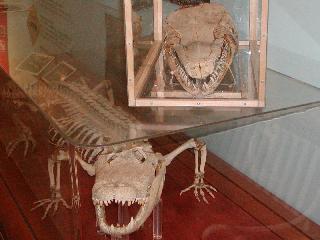 --
--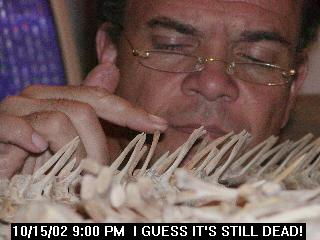 -
- 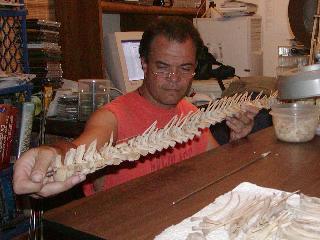
FRONT
VIEW
-------------
RICKUBIS
LIKES FISH-------------
---------------LONG
SPINE
September 24, 2002 This
series of pictures show the construction of the display for the
Alligator Gar skull. (pictures added 6/3/2015).
 -
- -
- -
-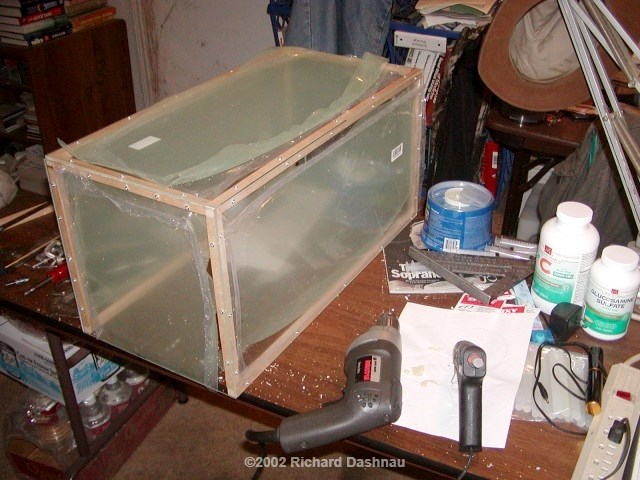
 -
-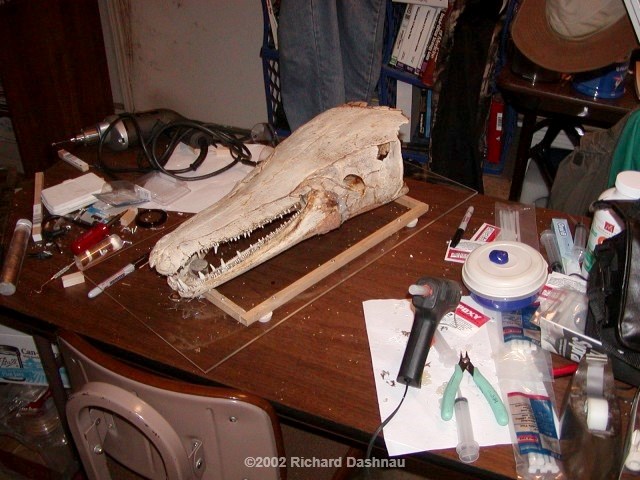 -
-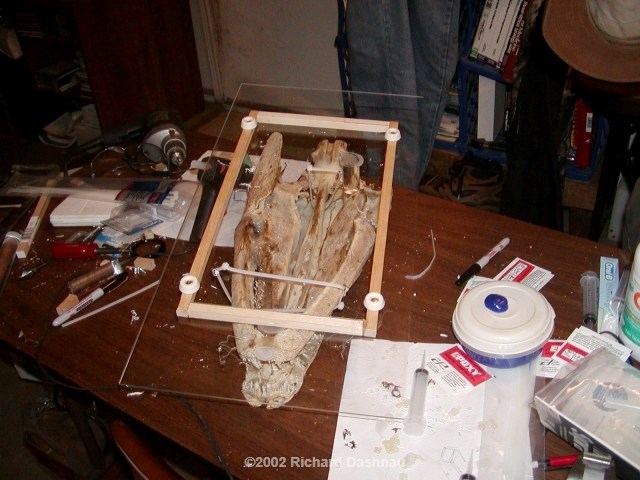 -
-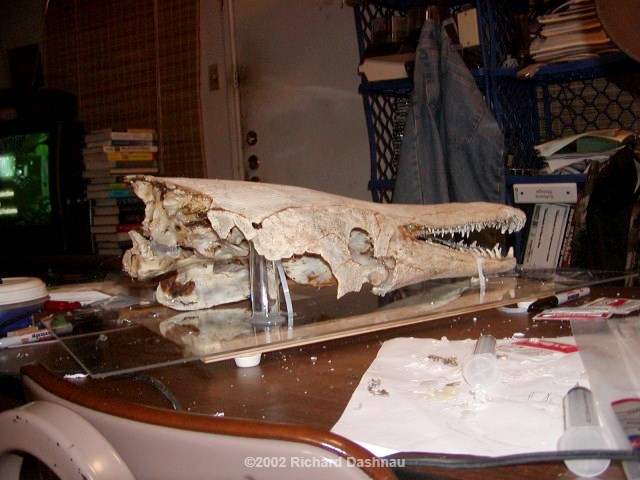
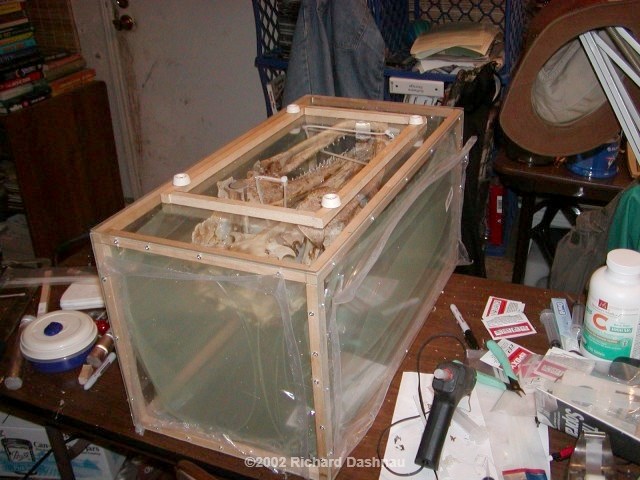 -
-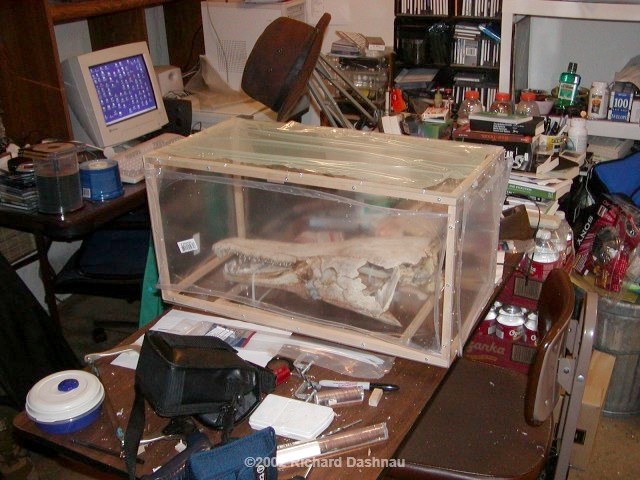 -
-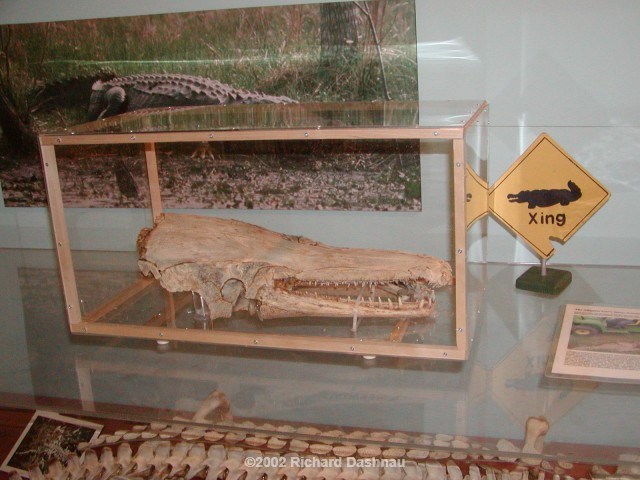 -
-
May
05, 2002 Tuesday,
April 23, I got to the park around 8:00 am. I hadn't been on the trail
10 minutes (I started at the 40-Acre Lake parking lot), when I
encountered
a copperhead stretched
across the trail near Hoot's Hollow. I
was able to take a few pictures before it got bored with me and
continued
across the trail.(COPPERHEAD, below)
Notice the coloration
of the scales
and the shape of the head. Also, the nostril is the small
opening at the tip of its nose. You might notice another opening
between
the nostril and the eye. This pit is what gives "pit vipers" their
name.
It's a heat sensor, and aids the snake in stalking food. Copperheads
are
poisonous, and as stated in signs throughout Brazos Bend State Park,
"POISONOUS
SNAKES EXIST IN
THIS PARK". The snakes belong in the park. Humans
are only visitors there. Visitors should keep a close eye on their
children
and pets while they are in the park, for this reason.
April
07, 2002
Kind of a quiet day today. More storm weather was due in our area.
However,
this morning, I was allowed to join David, one of the Park Naturalists,
and we took a quick
survey of some recently-deceased park denizens. Among
them was the huge gar that I've shown pictures of here, which I'd first
encountered on March 17. I'd wanted to do a quick dissection
of the gar
to determine what it might have eaten, but was unable to find it until
today; much too late for this. Making the best of the situation, I was
able to take some more pictures that showed
how large the gar is. Yes,
that is a John Deere Gator in the picture below (By the Gator),
next to the gar. I also took a few pictures of the skull. (MY
FOOT
(below)) and (TEETH (below)).
Those teeth are sharp!
--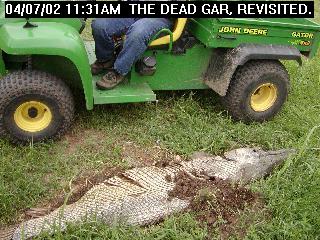 -
-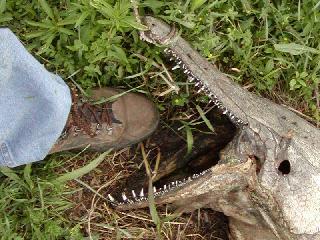 -
-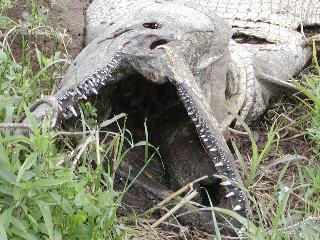 -
-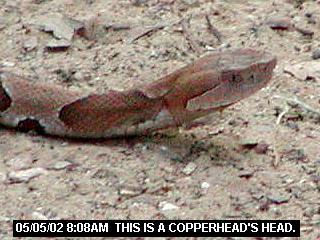
-BY
THE GATOR------
------MY
FOOT-M
-----
--------TEETH
COPPERHEAD-
March
17, 2002 They
were draining the Pilant Slough, and as the water level receded,
aquatic
creatures were trapped in waning pools of water. The alligators
evidently
capitalized on this turn
of events, and rested on the newly-exposed banks
near the observation tower in great numbers. See (lots of
gators)
below. Then, on the low end of the Slough, where the water was exiting
the floodgate, a large fish got caught in the concrete breakwater. This
was an alligator gar. See the images below. The first shot
shows
it as it was found. I tried to move this fish, but I was only
able to expose
its head, which had been crushed. Note the size of the
concrete uprights.
I'm standing on, and you'll get an idea of the scale of this fish. It
was
HUGE.
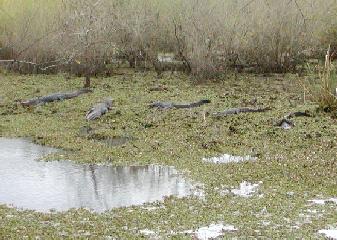 -
- -
-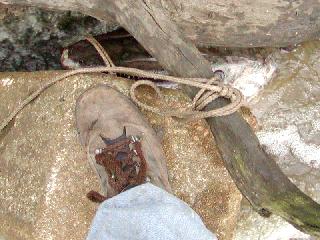 -
-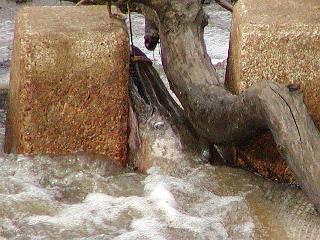
---
LOTS
OF GATORS----
---GAR
AS IT WAS FOUND-
---MY
FOOT BY THE HEAD----
------THE
HEAD------------
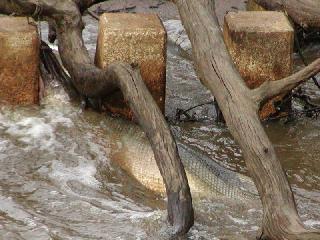
THE
ENTIRE FISH
The Alligator Gar's Story:
In March of 2002, the floodgate at the bottom of Pilant Slough, near
the Nature Center, was opened. This was done to drain the slough so
that
the floodgate could be repaired. Sometime
after this, a number of people
noticed a huge fish caught in the breakwater at the floodgate
opening.
Here is the fish as it appeared on March 17, 2002.
- -
- -
- -
-
GAR AS IT WAS FOUND---
-MY
FOOT BY THE HEAD--
--------THE
HEAD-------
-----THE
ENTIRE FISH
The fish is an Alligator Gar (Lepisosteus spatula). Note that
each one of those concrete ?teeth? in the floodgate is about one foot
across.
The gar was removed and dragged out to a remote
location in the park.
Alligator Gars will eat other fish, though it is reported
that they
will sometimes take waterfowl. It?s very likely that a gar will eat
anything
that it can catch, including turtles
and smaller alligators. Unfortunately,
too much time had passed before this gar could be examined to allow
dissection
for viewing its stomach contents. It should be noted here
that most
popular game fish, like Largemouth Bass, are generally too vigorous for
the Alligator Gar to catch.
Some time later, the condition of the gar was checked. The
plan was
to allow various park
scavengers to clean the carcass. Here are other pictures
of the gar, taken April 7, 2002.
-- -
- -
-
---
-BY
THE GATOR------
------MY
FOOT-M -----
--------TEETH
The gar is pictured near one of
the John Deere Gators used by Brazos
Bend State Park. The gar did not break down easily for a
number of
reasons. A hot, dry summer and the heavy scales
covering the body probably
prevented effective scavenging of the carcass. On April 23,
Park
Volunteer Rick Dashnau salvaged the head and developed this project.
The
gar?s head was
kept in the specimen freezer for some weeks while Rick and
the Park Naturalists tried to figure out how best to clean
it. What
made cleaning this prize so difficult was its size. It barely fits into
a five-gallon bucket! On August 7, a small cage was built (to prevent
larger
scavengers from disturbing the head), and the head was placed in an ant
nest for further cleaning. Finally, the skull
was clean enough to
work with. Rick Dashnau was able to finish cleaning and preparing the
skull,
and also able to build the case to display it on September 24,
2002.
I'll
note here that we measured one of these John Deer gators today. It was
8.5 feet long! Also, here are four more pictures of the Alligator
Gar.
The first one (ANT CAGE) shows the cage I
built for the head so I could
place it in an ant nest. The next two (STILL NOT, and 12 INCHES) show
the
head after the last treatment; a week long bath in a solution of 1
gallon
bleach/4 gallons
water. This was before I stripped off the remaining flesh.
The measurement is from the end of the snout to approximately the
center
of the eye socket. These were taken on September 19th...
the same day as
my images of the 3-fanged Cottonmouth. The next two (SIDE
VIEW, FRONT
VIEW) are of the gar's head as we first displayed it. We placed it on
top
of the display featuring
the skeleton of an 8-foot long alligator.
What
I can't stop thinking about is the image of this huge prehistoric fish
stalking the waters of the park--as large and as voracious as a
good-sized
alligator!
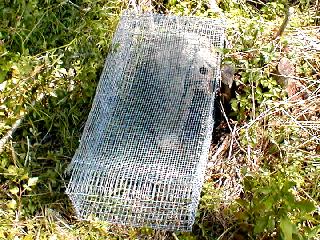 -
-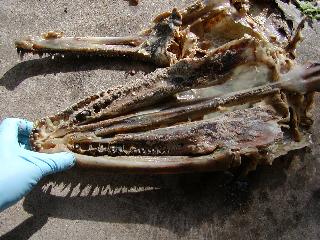 -
-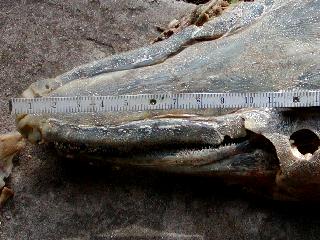 -
-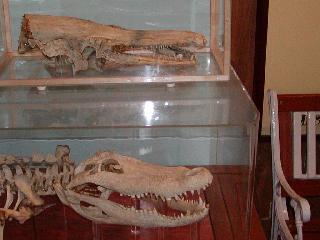
08/07/02
ANT CAGE
8STILL....NOT
QUITE
12 INCHES TIP TO
EYE
SIDE VIEW
The
gar is pictured near one of the John Deere Gators used by Brazos
Bend State Park. The gar did not break down easily for a
number of
reasons. A hot, dry summer and the heavy
scales covering the body probably
prevented effective scavenging of the carcass. On April 23,
Park
Volunteer Rick Dashnau salvaged the head and developed this project.
The
gar?s head
was kept in the specimen freezer for some weeks while Rick and
the Park Naturalists tried to figure out how best to clean
it. What
made cleaning this prize so difficult was its size. It barely
fits into
a five-gallon bucket! On August 7, a small cage was built (to prevent
larger
scavengers from disturbing the head), and the head was placed in an ant
nest for further cleaning. Finally,
the skull was clean enough to
work with. Rick Dashnau was able to finish cleaning and preparing the
skull,
and also able to build the case to display it on September 24,
2002.
If
you'd like to know more about the park follow these links:
Brazos
Bend State Park
The main page.
Brazos
Bend State Park Volunteer's Page The
volunteer's main page.
Go back to my home page, Welcome
to rickubis.com
Go
back to the RICKUBISCAM
page.
Go
back to the See
the World
page.
























































































































 -
- -
- -
-
 -
- -
- -
-
 -
- -
- -
- -
- -
- -
-








